Grumman F4F Wildcat

© Herbert Ringlstetter - www.aviaticus.com
Le Grumman F4F Wildcat était un chasseur embarqué utilisé par l'US Navy et la Royal Navy anglaise. D'abord utilisé en combat par les anglais en Europe, le Wildcat fut aussi et surtout utilisé par les américains dans le théâtre du Pacifique en 1941-1942. Le Wildcat fut remplacé par le rapide F6F Hellcat pour faire face au Zero. Mais le FM Wildcat fut toujours fabriqué par General Motors pour servir sur les porte-avions d'escorte où des chasseurs plus lourds et plus gros ne pouvaient être utilisés.
The Grumman F4F Wildcat was a carrier-based fighter aircraft used by both the US Navy and the British Royal. Although first used in combat by the British in Europe, the Wildcat was also and above all used by the Americans in the Pacific Theater in 1941-1942. The Wildcat was replaced by the faster F6F Hellcat to face the Zero. However, the FM Wildcat continued to be built by General Motors, to serve on escort carriers, where larger and heavier fighters could not be used.
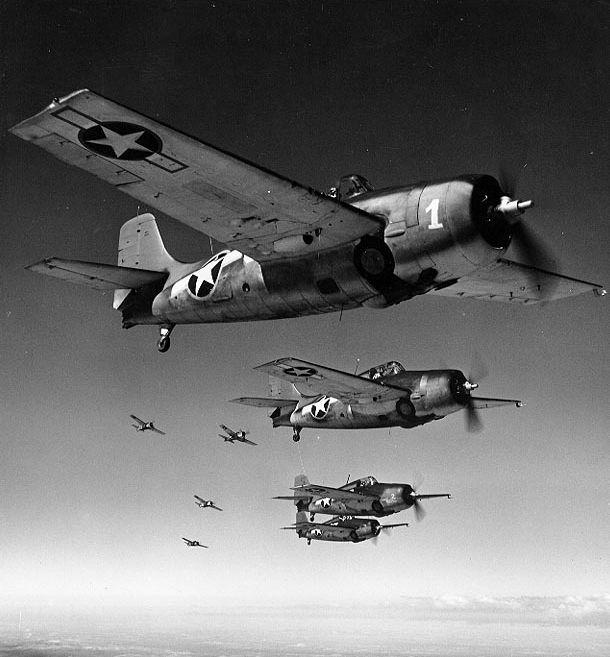
Grumman F4F - 1943 © US Navy (domaine public - public domain)
Développement - Development
Créée en 1929, la Grumman Aircraft Engineering Corporation fabriquait à ses débuts des flotteurs pour avions. Puis elle conçut le biplan de chasse XFF-1 à train rétractable dans le fuselage pour la Marine américaine. La Marine commanda ensuite à Grumman le biplan de chasse F2F-1 en 1934 ce qui entraîna le transfert de la fabrication sous licence du FF-1 à la Canadian Car & Foundry Company. Le F2F-1 fut amélioré et devint le F3F-1 (53 exemplaires), le F3F-2 (81 exemplaires) et le F3F-3 (27 exemplaires).
Founded in 1929, Grumman Aircraft Engineering Corporation manufactured at first floats for seaplanes. Then it designed for the American Navy the XFF-1 biplane fighter with the landing gear retractable in the fuselage. The Navy then ordered to Grumman the F2F-1 biplane fighter in 1934 which involved the transfer of the assembly under license of the FF-1 to the Canadian Car & Foundry Company. The F2F-1 was improved and became the F3F-1 (53 units), the F3F-2 (81 units) and the F3F-3 (27 units).
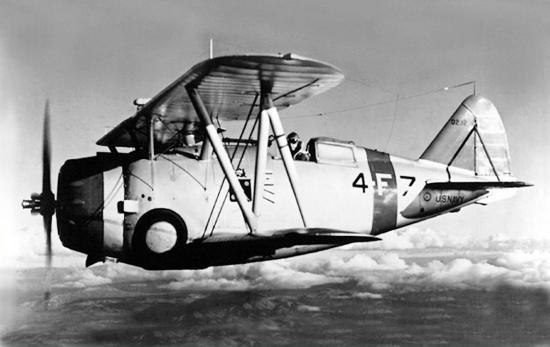
Grumman F3F-1 - VF4 - 1930
© US Navy (domaine public - public domain)
En Novembre 1935, la Navy lança un programme pour un chasseur embarqué. Grumman proposa un biplan équipé d'un moteur de 800 CV (projet G-16) et obtint un contrat prévoyant la construction d'un prototype, le XF4F-1 (2 mars 1936). Pour diverses raisons, celui-ci fut abandonné.
In November 1935, the Navy launched a program for a carrier-based fighter aircraft. Grumman proposed a biplane powered by a 800 HP engine (project G-16) and obtained a contract for the construction of a prototype, the XF4F-1 (March 2nd, 1936). For various reasons, this project was stopped.
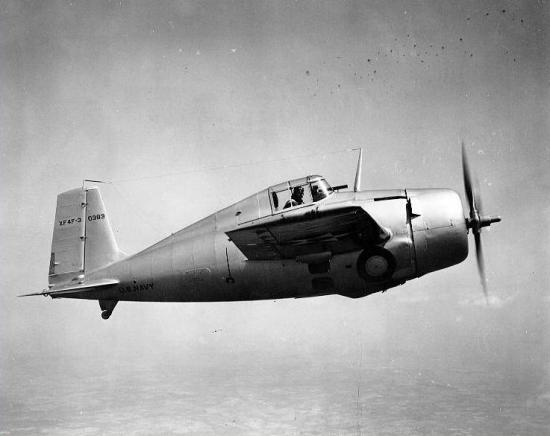
XF4F-3 (BuAer 0383). Le prototype en vol en avril 1939. Prototype in flight in April 1939.
© Naval Historical Center - (US Navy) - www.history.navy.mil
 Après avoir hésité entre biplan et monoplan, la Navy adopta le monoplan mais en petites quantités et commanda le Brewster F2A-1 Buffalo en juin 1936. Par réaction, Grumman proposa le monoplan F4F-2 et obtint un contrat pour la fabrication d'un prototype le 28 juillet 1936. Pendant 2 ans, le Brewster XF2A-1 et le Grumman XF4F-2 étaient en concurrence.
Après avoir hésité entre biplan et monoplan, la Navy adopta le monoplan mais en petites quantités et commanda le Brewster F2A-1 Buffalo en juin 1936. Par réaction, Grumman proposa le monoplan F4F-2 et obtint un contrat pour la fabrication d'un prototype le 28 juillet 1936. Pendant 2 ans, le Brewster XF2A-1 et le Grumman XF4F-2 étaient en concurrence.
After having hesitated between biplane and monoplane, the Navy adopted the monoplane but in small quantities and ordered some Brewster F2A-1 Buffalo in June 1936. Very reactive, Grumman proposed the monoplane F4F-2 and obtained a contract for the manufacture of a prototype on July 28th, 1936. For 2 years, the Brewster XF2A-1 and Grumman XF4F-2 were in competition.
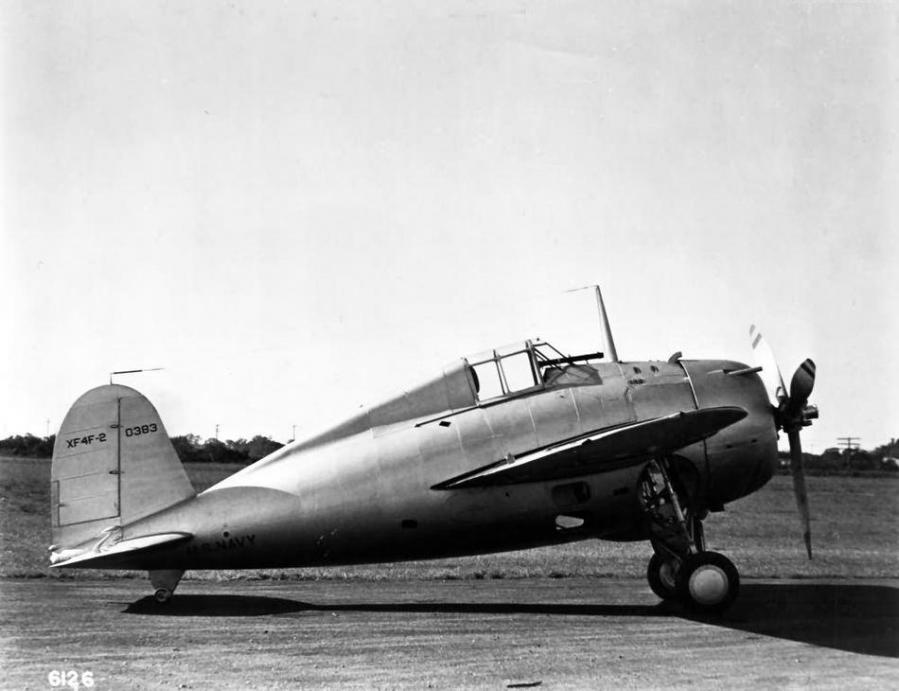
Prototype XF4F-2 BuNo 0383, Bethpage © Grumman Aircraft Corporation
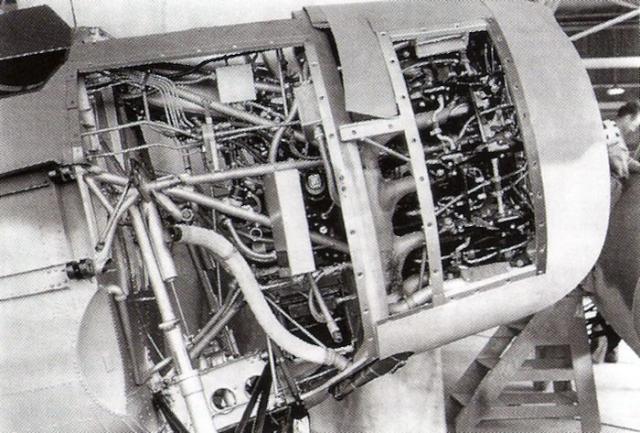
F4F-3, moteur/engine P&W R-1830
© US Navy (domaine public - public domain)
Le XF4F-2 effectua son premier vol le 2 septembre 1937 (avion n° 0383 - pilote Robert L. "Bob" Hall) : il était équipé d'un moteur Pratt & Whitney SC-G Twin Wasp R-1830-66 de 1050 CV.
The XF4F-2 accomplished its first flight on September 2nd, 1937 (plane #0383 - pilot Robert L. "Bob" Hall) : it was powered by a Pratt & Whitney engine SC-G Twin Wasp R-1830-66 of 1050 HP.
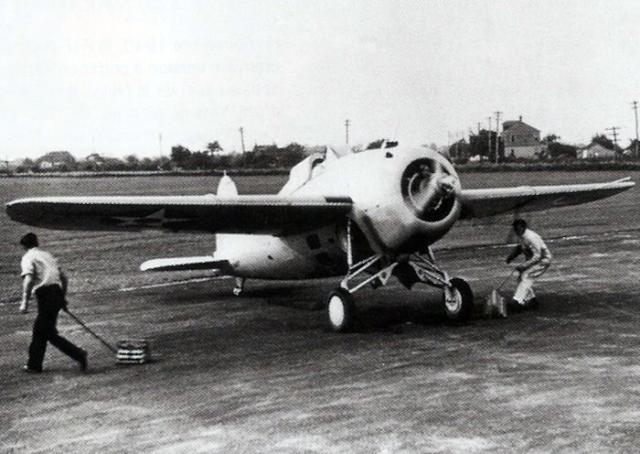
Prototype XF4F-2
© US Navy (domaine public - public domain)
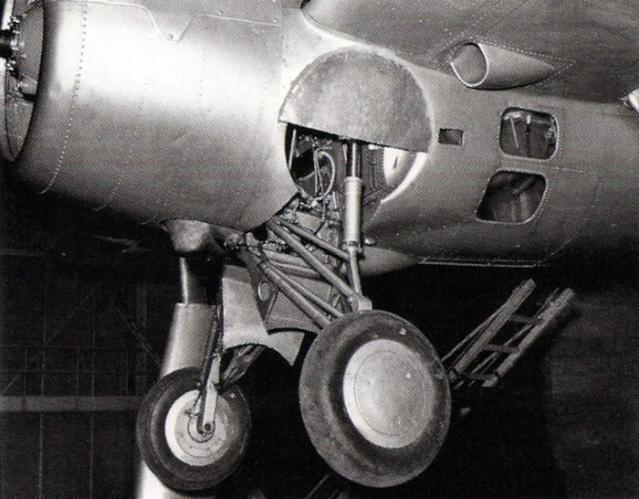
XF4F-2 - train d'atterissage, landing gear
© US Navy (domaine public - public domain)
Equipé du train escamotable typique de Grumman (système actionné à la main par manivelle conçu à l'origine pour Grover Loening dans les années 20), l'avion avait deux mitrailleuses Browning de 12,7 mm (0.50 pouces) dans le capot et pouvait recevoir deux autres mitrailleuses dans les ailes et deux bombes de 100 livres.
Fitted with the typical Grumman retractable landing gear (hand-cranked landing gear designed at the origin for Grover Loening in the 20's), the aircraft had two 0.50 in. (12.7 mm) Browning machine-guns in the engine hood and could receive two other machine-guns in the wings and two 100 pounds bombs.
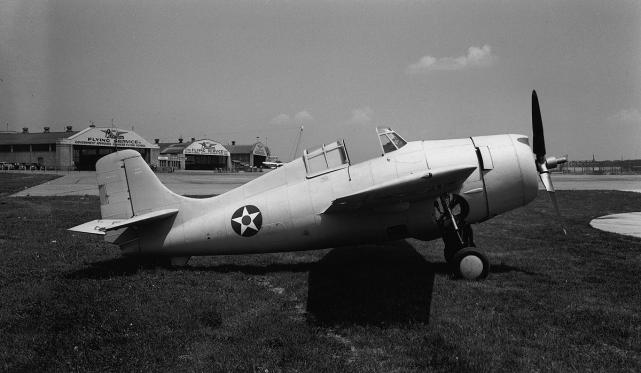
F4F-3A, Naval Air Station St Louis, Missouri, USA, 1940 © US Navy (domaine public - public domain)
En juin 1938 (après que le prototype du XF4F-2 soit endommagé le 11 avril 1938), la Navy opta pour le Brewster F2A-1 mais ordonna la poursuite du développement du XF4F-2.
In June 1938 (after the XF4F-2 prototype was damaged on April 11th, 1938), the Navy chose the Brewster F2A-1 but ordered the continuation of the XF4F-2 development.
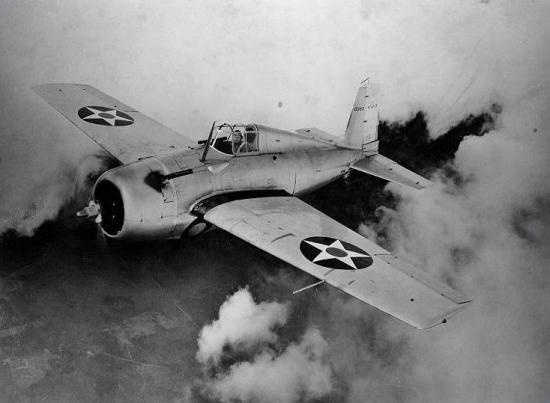
XF4F-3 Naval Historical Center - (US Navy) - www.history.navy.mil
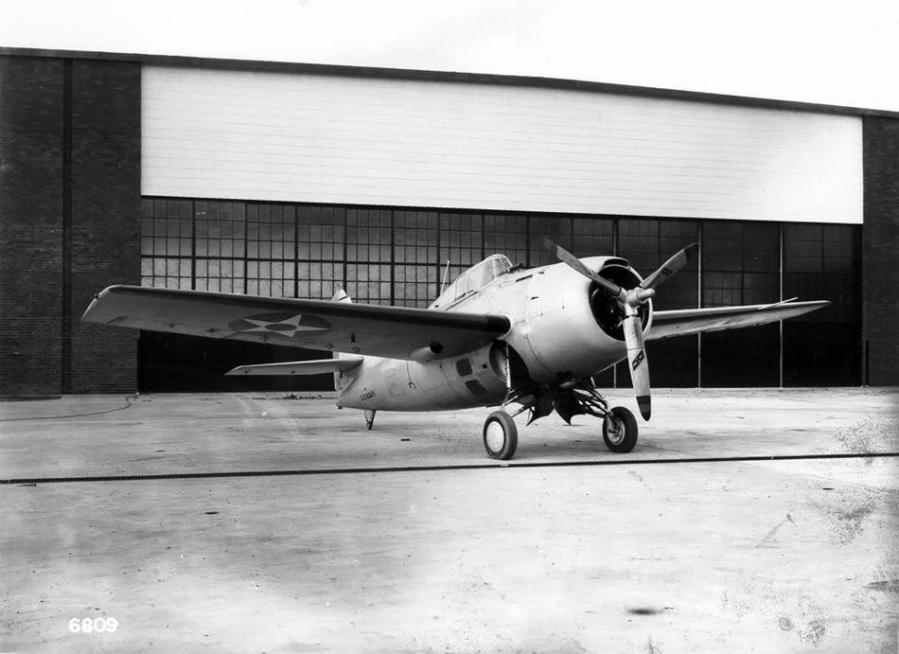
Prototype XF4F-3 BuNo 0383, Bethpage © Grumman Aircraft Corporation
Le XF4-3, équipé d'un moteur P&W R-1830-76 fut créé. Bien que différent, il conserva le numéro 0383.
The XF4-3, powered by a P&W R-1830-76 engine, was then created. Although different, it kept the number 0383.
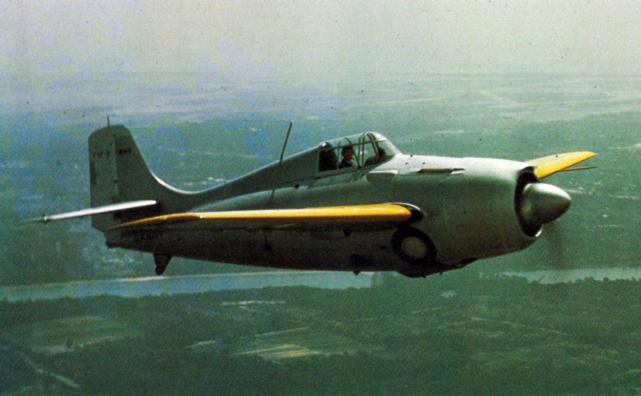
F4F-3 BuAer 1845 - Eté 1940 - Summer 1940 - © US Navy (domaine public - public domain)
Il vola pour la première fois le 12 février 1939. Le prototype fut ensuite modifié et la Navy commanda 34 modèles de F4F-3 en août 1939. Le programme d'essais se termina avec l'accident du prototype à Norfolk en décembre 1940.
It flew for the first time on February 12th, 1939. The prototype was then modified and the Navy ordered 34 units of F4F-3 in August 1939. The test program ended with the accident of the prototype in Norfolk in December 1940.
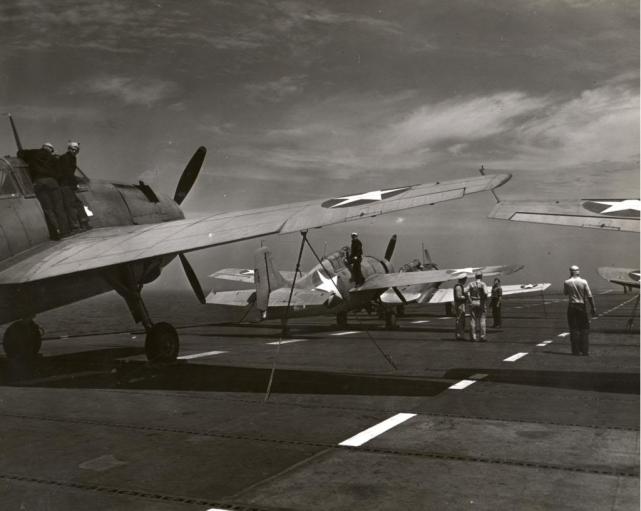
F4F - USS Wolverine, Lake Michigan, USA - 1943
© US Navy (domaine public - public domain)

Production en série - Production series.
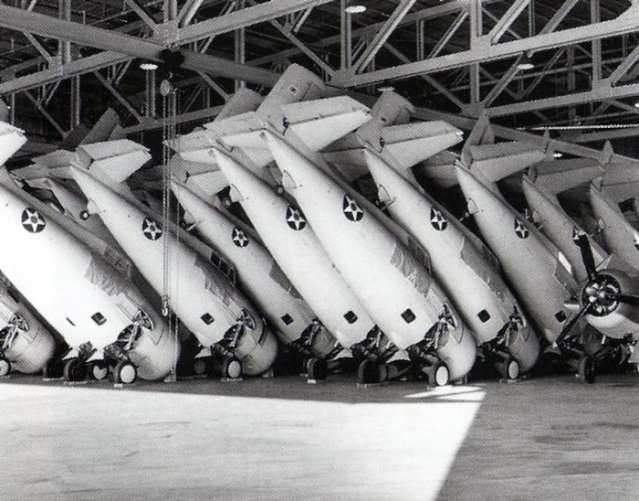
Grumman F4F-3 © US Navy (domaine public - public domain)
Fabriqué dans l'usine de Bethpage, le premier F4F-3 de série (BuAer 1844) vola en février 1940 et le second (BuAer 1845) 5 mois plus tard. Ils avaient deux mitrailleuses de 7,62 mm (0.30 pouces) sur le capot et deux de 12,7 mm (0.50 pouces) dans les ailes.
Manufactured in the Bethpage factory, the first series unit F4F-3 (BuAer 1844) flew in February 1940 and the second one (BuAer 1845) 5 months later. They received two 0.30 in. (7.62 mm) machine-guns on engine hood and two 0.50 in. (12.7 mm) in the wings.
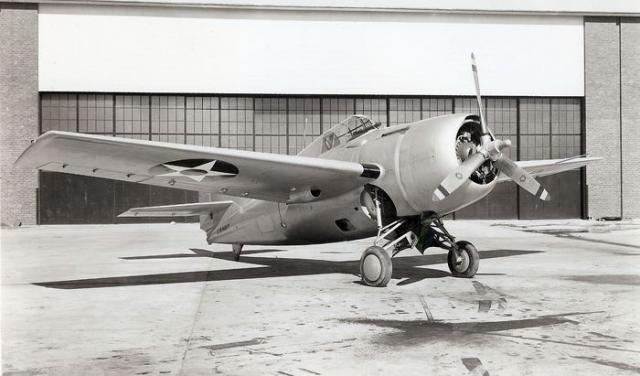
F4F-3 BuAer 1844 - Bethpage, 1941 - © US Navy (domaine public - public domain)
Les F4F-3 suivants reçurent seulement 4 mitrailleuses de 12,7 mm dans les ailes et leur blindage et train d'atterissage furent renforcés. Les F4F-3 avaient des ailes fixes.
The following F4F-3s received only four 0.50 in. machine-guns in the wings and their shielding and landing gear were reinforced. The F4F-3 had fixed wings.
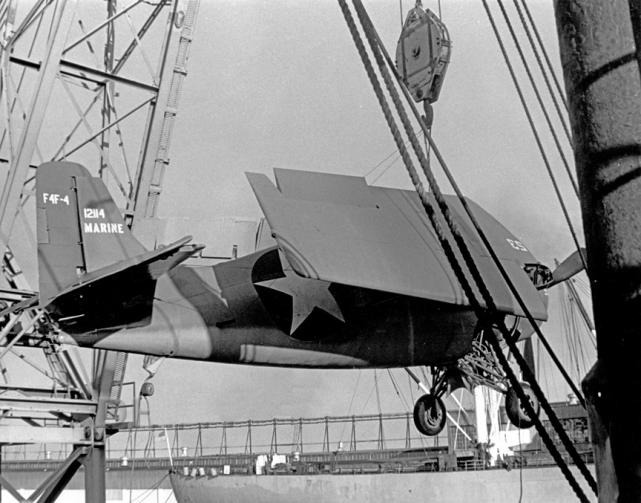
Chargement d'un F4F-4 sur un porte-avions, ailes repliées
Loading of a F4F-4 on board an aircraft-carrier, wings folded
© US Navy (domaine public - public domain)
En avril 1941, le XF4F-4 fut équipé d'ailes repliables. Le moteur R-1830-76 connaissait de nombreux problèmes et fut remplacé par le P&W R-1830-90 avec le F4F-3 BuAer 7031 qui devint XF4F-6 : ce modèle d'essais s'écrasa en mai 1942. 95 modèles de F4F-6, baptisés F4F-3A furent ainsi commandés et 65 servirent dans l'U.S. Marine Corps.
In April 1941, the XF4F-4 was equipped with foldable wings. The R-1830-76 engine faced many problems and was replaced by the P&W R-1830-90 with the F4F-3 BuAer 7031 which became XF4F-6 : this testing model was crashed in May 1942. 95 units of F4F-6, named F4F-3A were thus ordered and 65 were used in the U.S. Marine Corps.
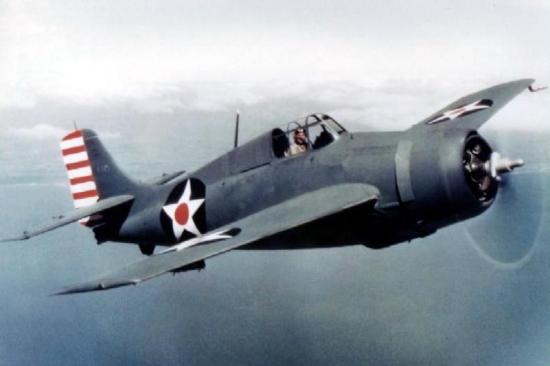
F4F-3 - Début 1942 - Early 1942 - © US Navy (domaine public - public domain)
Suite à une commande française d'une centaine de F4F-3 à l'automne 1939, on équipa les F4F-3 1846 et 1847 d'un moteur Wright R-1820-40 de 1200 CV qui devinrent XF4F-5 en avril 1940 : à cause de la capitulation de juin 1940, la commande fut reprise par les Anglais et le premier Martlet (version anglaise du Wildcat) fut livré le 27 juillet 1940.
For a French order of one hundred F4F-3 to the autumn 1939, the F4F-3 1846 and 1847 were fitted with a Wright R-1820-40 engine of 1200 HP which led to the XF4F-5 in April 1940 : because of the capitulation of June 1940, the order was taken by the English and the first Martlet (english version of the Wildcat) was delivered on July 27th, 1940.
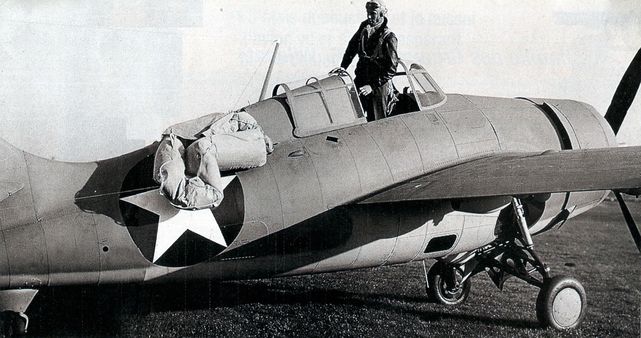
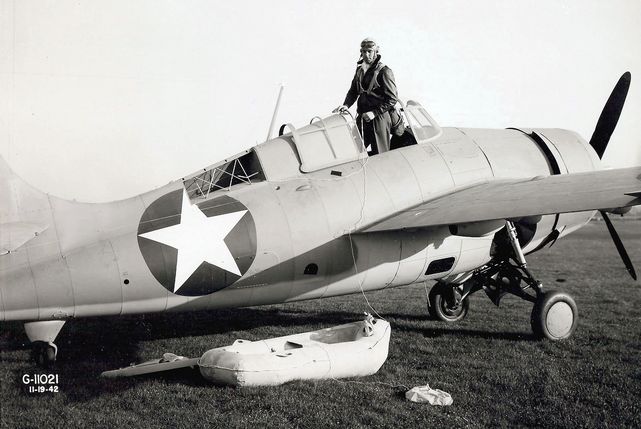
Grumman F4F Wildcat
Essai de deploiement de canot de sauvetage par le pilote d'essais chez Grumman, Corwin "Corky" H. Meyer en novembre 1942. Suite à des incidents de gonflage, ce modèle sera remplacé par le monoplace PK-2, empaqueté sous le parachute.
Pilot's life raft deployment demonstration by Grumman's test pilot, Corwin "Corky" H. Meyer in November, 1942. Further to incidents of inflating, this model was replaced by the single-seater PK-2, packed under the parachute.
© US Navy (domaine public - public domain)
 Le surnom ‘Wildcat' fut officiellement adopté le 1er octobre 1941. La Navy réclama un appareil de reconnaissance à long rayon d'action : ce fut le F4F-7 avec des réservoirs dans les ailes (permettant une capacité maximale de 2590 l) et pas d'armement. Le F4F-7 vola pour la première fois le 30 décembre 1941. Une centaine de F4F-7 furent commandés mais seulement 21 fabriqués.
Le surnom ‘Wildcat' fut officiellement adopté le 1er octobre 1941. La Navy réclama un appareil de reconnaissance à long rayon d'action : ce fut le F4F-7 avec des réservoirs dans les ailes (permettant une capacité maximale de 2590 l) et pas d'armement. Le F4F-7 vola pour la première fois le 30 décembre 1941. Une centaine de F4F-7 furent commandés mais seulement 21 fabriqués.
The nickname "Wildcat" was officially adopted on October 1st, 1941. The Navy claimed for a long-range recognition aircraft : it was the F4F-7 with tanks in the wings (allowing a maximum capacity of 2590 L) and no armament. The F4F-7 flew for the first time on December 30th, 1941. One hundred F4F-7 were ordered but only 21 manufactured.
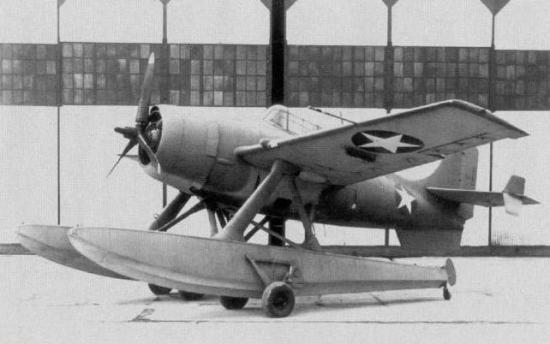
F4F-3S Wildcatfish (BuAer 4038) - © US Navy (domaine public - public domain)
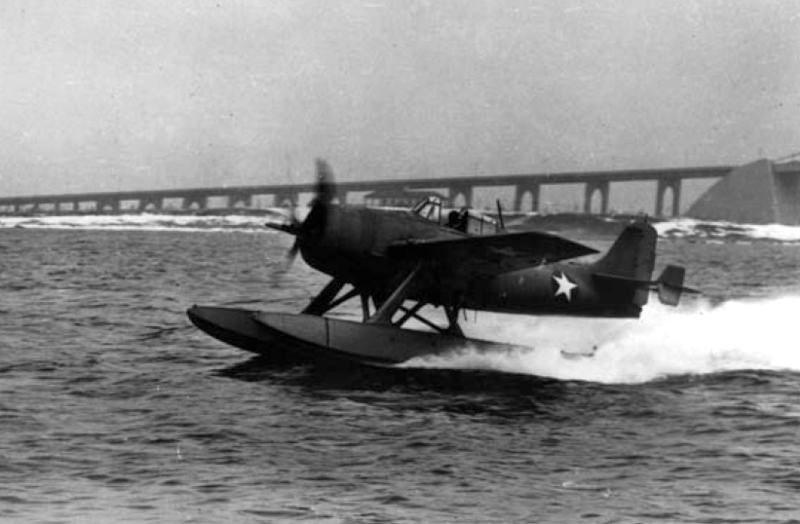
F4F-3S Wildcatfish, NAS Norfolk, 1943 - © US Navy (domaine public - public domain)
A l'automne 1942, la Navy demanda un hydravion de chasse pour des opérations dans les archipels du Pacifique dépourvus d'aérodromes. Un F4F-3 (BuAer 4038) fut modifié par la Edo Corporation et rebaptisé F4F-3S Wildcatfish. Il fit un premier vol le 28 février 1943.
During autumn 1942, the Navy asked for a fighter seaplane to be operated in the archipelagoes of the Pacific which had no airfields. A F4F-3 (BuAer 4038) was modified by the Edo Corporation and renamed F4F-3S Wildcatfish. It made its maiden flight on February 28th, 1943.
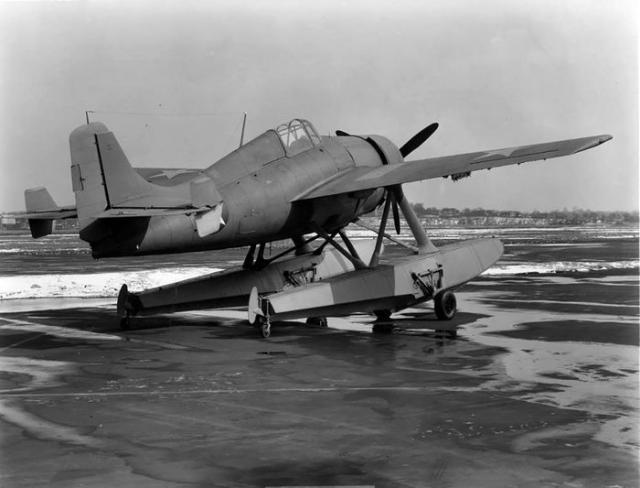
F4F- Wildcatfish - © US Navy (domaine public - public domain)
La vitesse était descendue à 390 km/h (241 mph). Edo Corp. approvisionna 100 jeux de flotteurs. Mais le projet fut finalement abandonné avec l'augmentation du nombre de porte-avions et l'aptitude de l'armée à construire rapidement des aérodromes dans les îles.
The speed decreased to 241 mph (390 km/h). Edo Corp. provided 100 sets of floats. But the project was finally stopped with the increase of aircraft-carriers and the aptitude of the army to quickly build airfields in the islands.
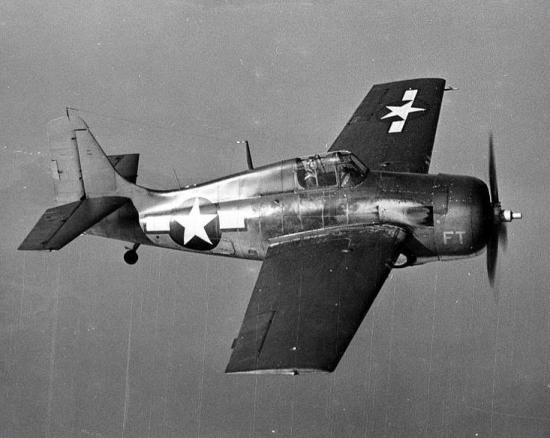
FM-2 - Essais en vol fin 1943. Flight testing late 1943.
© Naval Historical Center - (US Navy) - www.history.navy.mil
Des essais de remorquage de F4F-3 par des Douglas A-20 ou des Boeing B-17 eurent lieu mais furent sans suite. Grumman étant très occupée avec la fabrication des F6F et TBF Avenger, l'Eastern Aircraft (division aéronautique de General Motors) reçut un contrat d'assemblage de 1800 FM-1, copie conforme du F4F-4.
Towing tests of F4F-3 by Douglas A-20 or Boeing B-17 were done but without continuation. Because Grumman was very charged with the manufacture of the F6F and TBF Avenger, the Eastern Aircraft (aeronautical division of General Motors) accepted a n assembling contract of 1800 FM-1 units, a copy of the F4F-4.
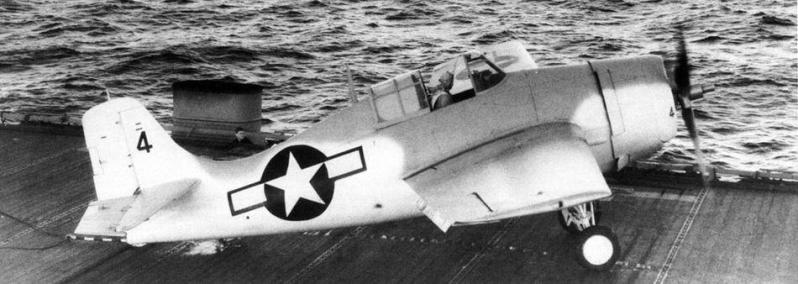
Eastern Aircraft FM-1 (BuNo 46776), VC-58 - USS Guadalcanal (CVE-60), 13 janvier 1944 - 13th January, 1944
© US Navy (domaine public - public domain)
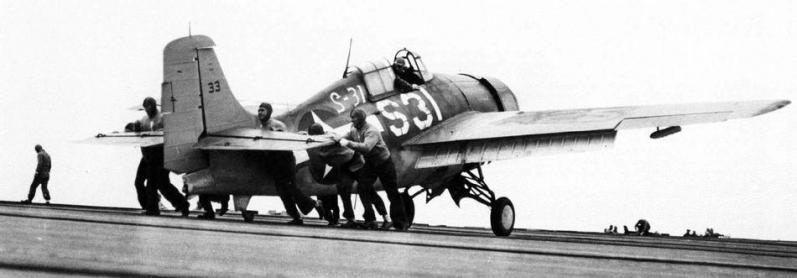
Eastern Aircraft FM-1, VC-33 - USS Nassau (CVE-16), 6 septembre 1943 - 6th September, 1943
© US Navy (domaine public - public domain)
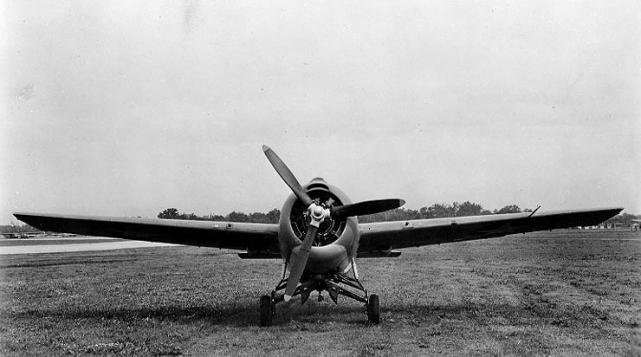
Wildcat - 1942/1943 - © US Navy (domaine public - public domain)
Mais les exigences de la Navy et des portes-avions obligèrent Grumman à modifier le Wildcat en allégeant la cellule et en adaptant un moteur plus performant.
But the requirements of the Navy and the aircraft carriers obliged Grumman to modify the Wildcat by reducing the weight of cell and by adapting a more powerful engine.
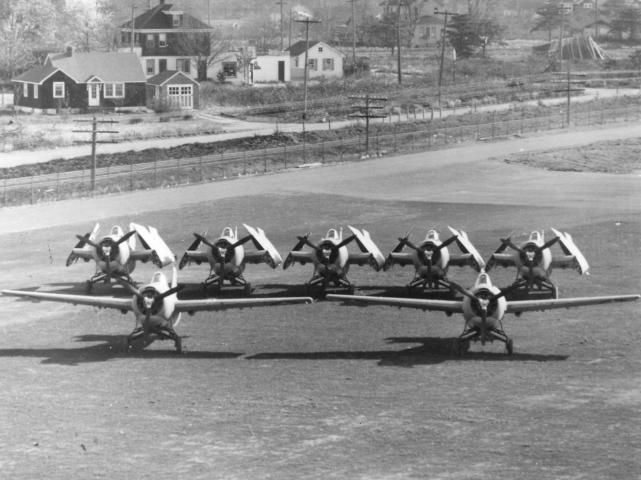
F4F-4 - 1942.
© National Museum of Naval Aviation - www.navalaviationmuseum.org
 Le XF4F-8 (BuAer 12228) prit ainsi l'air en novembre 1942 avec un moteur Wright R-1820-56 Cyclone. Le souffle de l'hélice plus important obligea à agrandir les surfaces verticales à partir du BuAer 12229. Grumman fabriqua le prototype mais la Eastern Aircraft assembla les versions de série sous le nom de FM-2.
Le XF4F-8 (BuAer 12228) prit ainsi l'air en novembre 1942 avec un moteur Wright R-1820-56 Cyclone. Le souffle de l'hélice plus important obligea à agrandir les surfaces verticales à partir du BuAer 12229. Grumman fabriqua le prototype mais la Eastern Aircraft assembla les versions de série sous le nom de FM-2.
The XF4F-8 (BuAer 12228) thus flew in November 1942 with a Wright R-1820-56 Cyclone engine. The more important propeller power obliged to increase vertical surfaces with model BuAer 12229. Grumman manufactured the prototype but Eastern Aircraft assembled the production units under the name of FM-2.
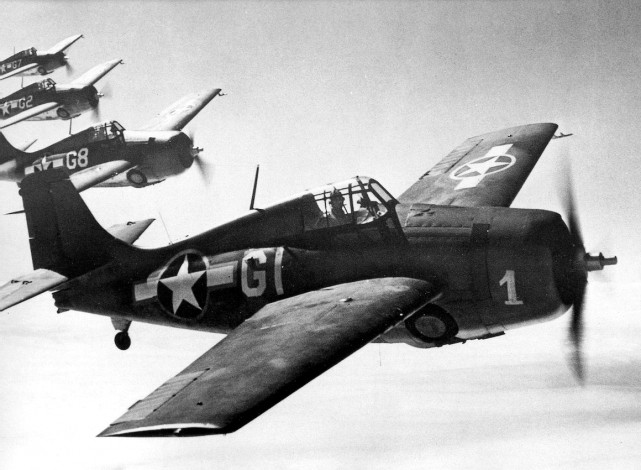
Grumman F4F Wildcat
© US Navy (domaine public - public domain)
Pour l'entraînement des pilotes, la Navy fit transformer en porte-avions d'entraînement deux anciens bateaux de tourisme à roues à aubes et chaudières à charbon, devenus USS Sable (IX-81) et Wolverine (IX-84). Ils furent armés respectivement en août 1942 et mai 1943. Ces bateaux navigaient sur le lac Michigan pour former les pilotes, LSO (Landing Signal Officers) et les équipes de pont.
To train the pilots, the Navy transformed into training aircraft-carriers two old tourism boats with water wheels and coal-fired boilers, which became USS Sable (IX-81) and Wolverine (IX-84). They were respectively crewed in August, 1942 and May, 1943. These boats operated on the Lake Michigan to train the pilots, the LSO (Landing Signal Officers) and the deck teams.
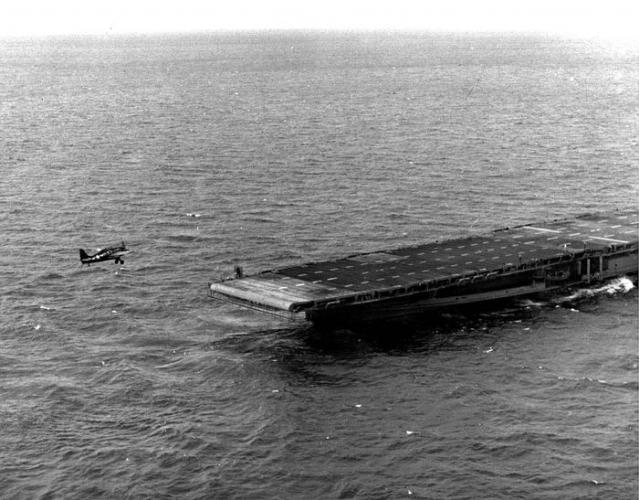
General Motors FM-2, USS Sable, Lake Michigan, 1944.
© US Navy (domaine public - public domain)
Un dispositif de ballonets de flottaison équipera dans un premier temps les Wildcat pour les cas d'appontage manqué ou d'amerrissage. Ce dispositif sera abandonné ensuite suite à des ouvertures accidentelles en vol qui entraîna la mort d'un pilote.
A floatation device with balloons was first fitted on Wildcat for the cases of missed deck-landing or sea landing. This device was later abandoned further to accidental openings during flight which involved the death of a pilot.
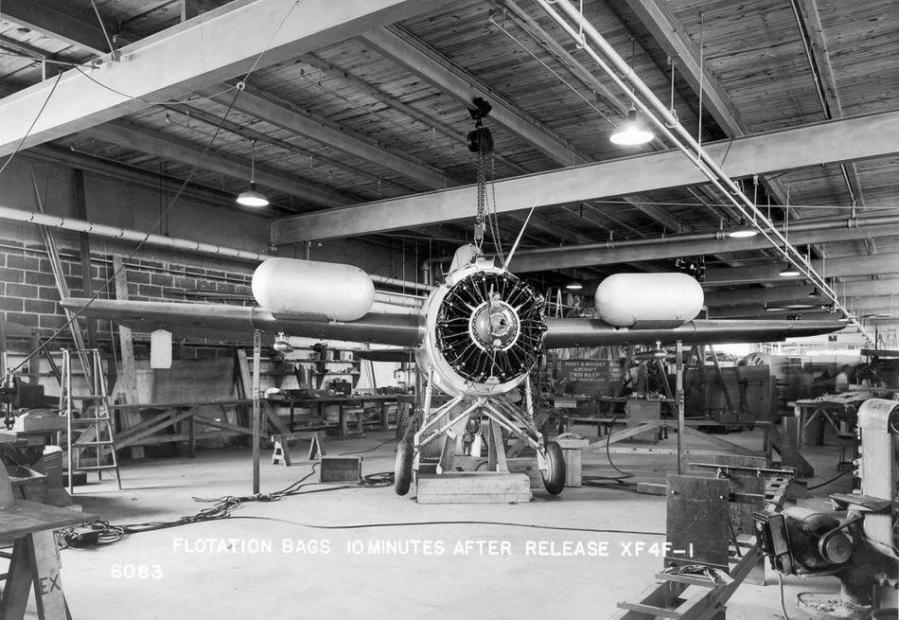
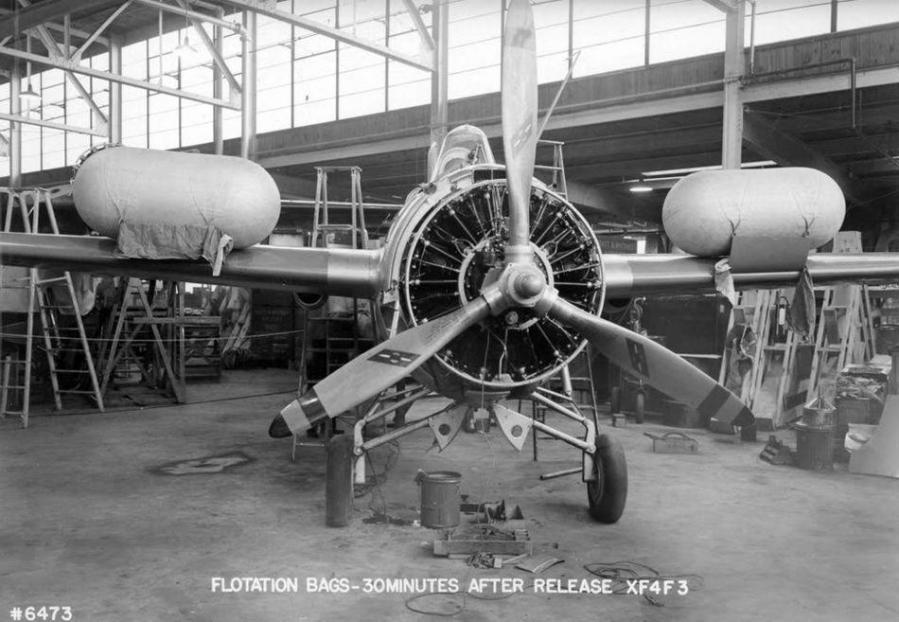
Grumman Wildcat XF4F-3 - Essai de ballons de flotaison - Flotation bags testing.
© US Navy (domaine public - public domain)
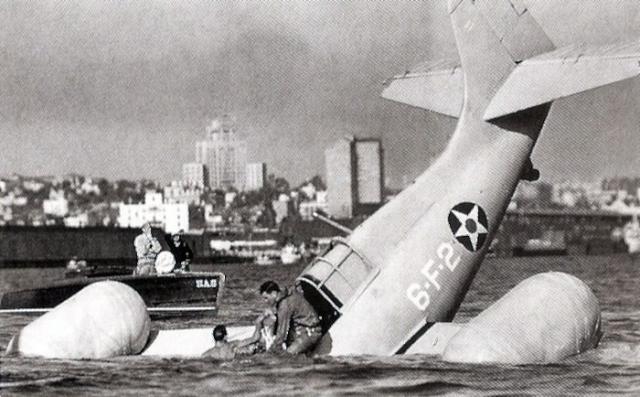
Grumman Wildcat F4F-3, VF-6, San Diego, 1941.
© US Navy (domaine public - public domain)
Versions - Variants
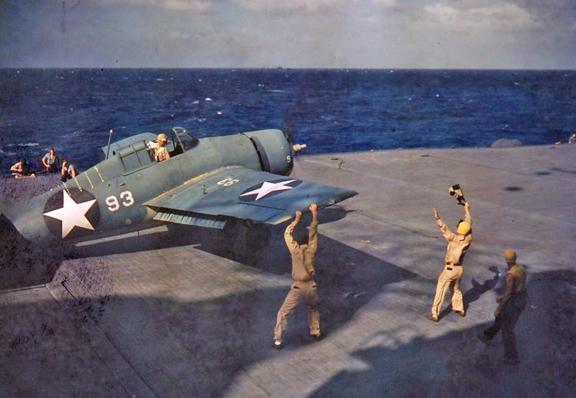 Grumman F4F - © US Navy (domaine public - public domain)
Grumman F4F - © US Navy (domaine public - public domain)
XF4F-1
Prototype biplan, modèle G-16, commandé en mars 1936. Moteur Wright XR-1620-2 de 900 CV ou encore Pratt & Whitney XR-1535-92 de 875hp avec hélice à 2 pales. Armement projeté: 1 mitrailleuse de 0.3 pouces (12,7 mm) et 1 de 0.5 sur le capot moteur ou encore toutes les 2 de 0.5, train escamotable dans le fuselage. Projet abandonné.
Biplane prototype, model G-16, ordered in March 1936. Engine Wright XR-1620-2 of 900 HP or Pratt & Whitney XR-1535-92 of 875 HP with propeller with 2 blades. Projected armament : 1 machine-gun of 0.3 inches (12.7 mm) and 1 of 0.5 on the engine hood or both of 0.5, retractable landing gear in the fuselage. Project stopped.
XF4F-2
1er prototype monoplan, modèle G-18, sur la base du XF4F-1 avec moteur Pratt & Whitney R-1830-66 de 1050 CV. Armement : 2 mitrailleuses de 0.5 pouces (12,7 mm) sur le capot et possibilité d'en monter aussi 1 autre par aile en plus des 2 bombes de 100 livres sous les ailes. Commandé en juillet 1936, 1er vol le 2 septembre 1937 (avion n°0383), endommagé en avril 1938.
1st prototype monoplane, model G-18, based on the XF4F-1 with Pratt & Whitney R-1830-66 engine of 1050 HP. Armament : 2 machine-guns of 0.5 inches (12.7 mm) on the hood and possibility of assembling 1 other per wing besides the 2 bombs of 100 pounds under the wings. Ordered in July 1936, 1st flight on September 2nd, 1937 (aircraft n°0383), damaged in April 1938.
XF4F-3
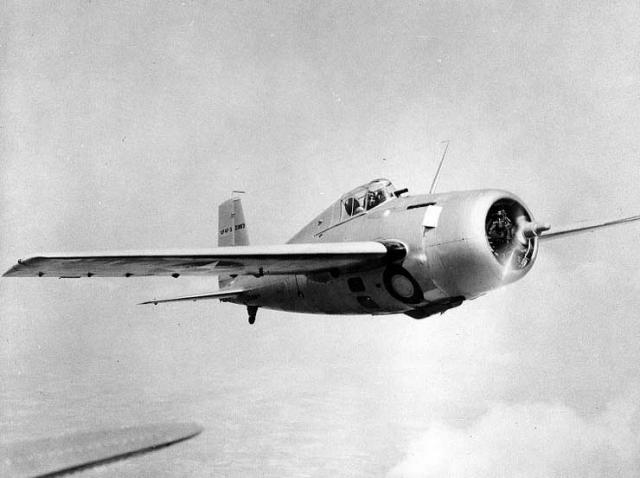
XF4F-3 (BuAer 0383) - Le prototype en vol en avril 1939. Prototype in flight in April 1939.
© Naval Historical Center - (US Navy) - www.history.navy.mil
2e prototype monoplan, modèle G-36, le prototype XF4F-2 est modifié avec des ailes plus grandes et plus larges de 4 pieds (1219.2 mm) et avec des extrémités non plus arrondies mais carrées, moteur Pratt & Whitney XR-1830-76 Twin Wasp de 1200 CV. 2 mitrailleuses de 0.5 pouces (12,7 mm) dans les ailes et deux de 0.3 pouces (7,62 mm) sur le capot. Commandé en juin 1938, 1er vol en février 1939 (même numéro 0383) et détruit en décembre 1940.
2nd prototype monoplane, model G-36, the prototype XF4F-2 is modified with larger and broader wings of 4 feet (1219.2 mm) and with either round but square ends, engine Pratt & Whitney XR-1830-76 Twin Wasp of 1200 HP. 2 machine-guns of 0.5 inches (12.7 mm) in the wings and two of 0.3 inches (7.62 mm) on the hood. Ordered in June 1938, 1st flight in February 1939 (same number 0383) and destroyed in December 1940.
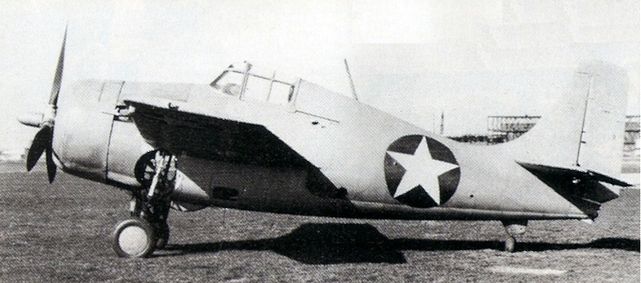
Grumman XF4F-3 - © US Navy (domaine public - public domain)
F4F-3
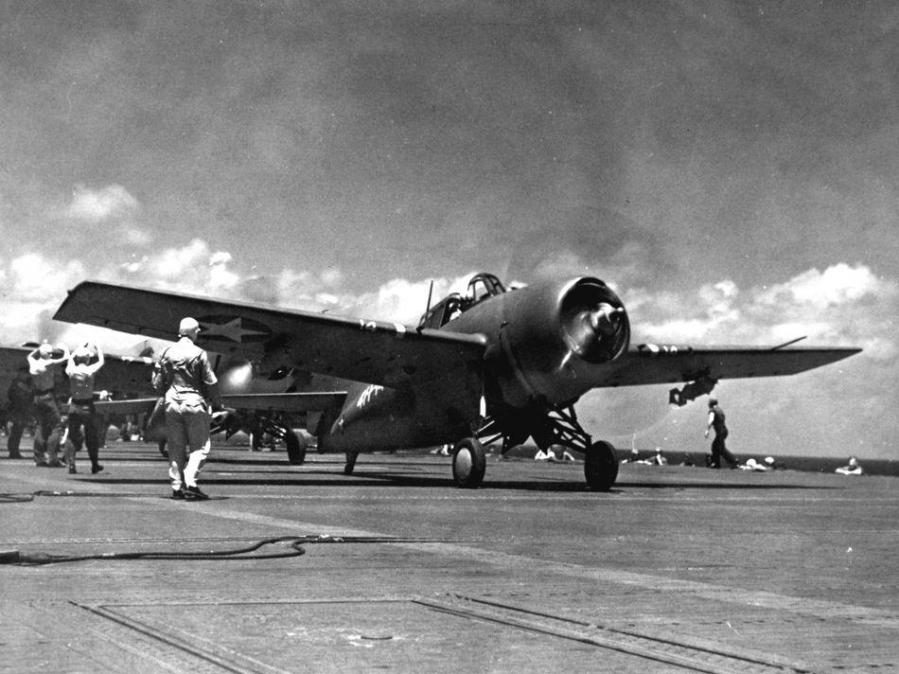
Grumman Wildcat F4F-3 - VF-41, USS Ranger (CV-4), 1942
Armé de bombes de 100 livres - PArmed with 100 pounds bombs
© US Navy National Naval Aviation Museum NNAM.1996.253.7386.007 (domaine public - public domain)
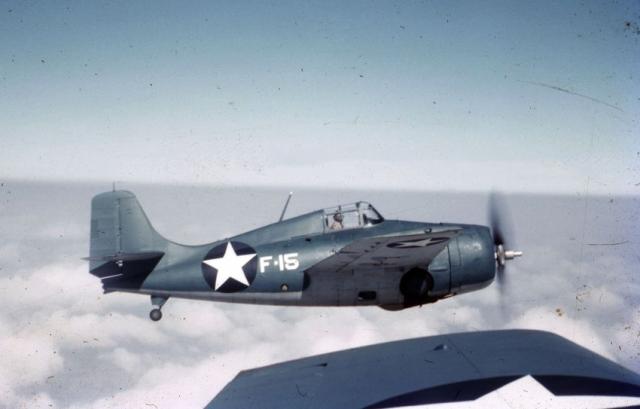
Grumman Wildcat F4F-3 - 1942
Peut-être celui de Butch O'Hare - Possibly Butch O'Hare's Wildcat
© US NARA (domaine public - public domain)
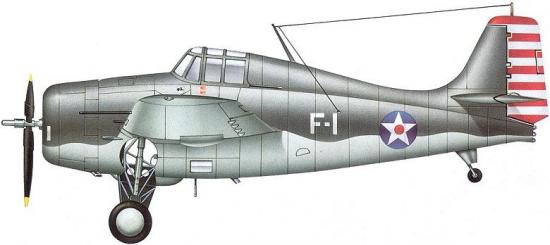
F4F-3 - VF-3 - USS Saratoga, 1941-1942 - Lt.Cdr.John Smith Thach 'Jimmy'
artiste inconnu - artist unknown - source : http://wp.scn.ru
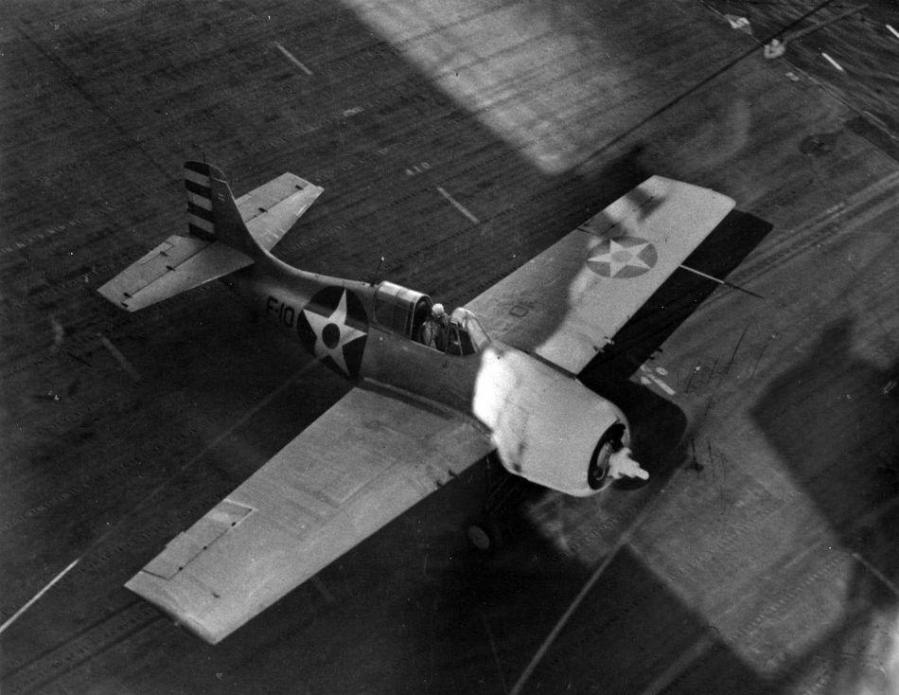
F4F-3 - code F-10 - VF-6. USS Enterprise (CV-6), 1942.
© US Navy photo 80-G-73679
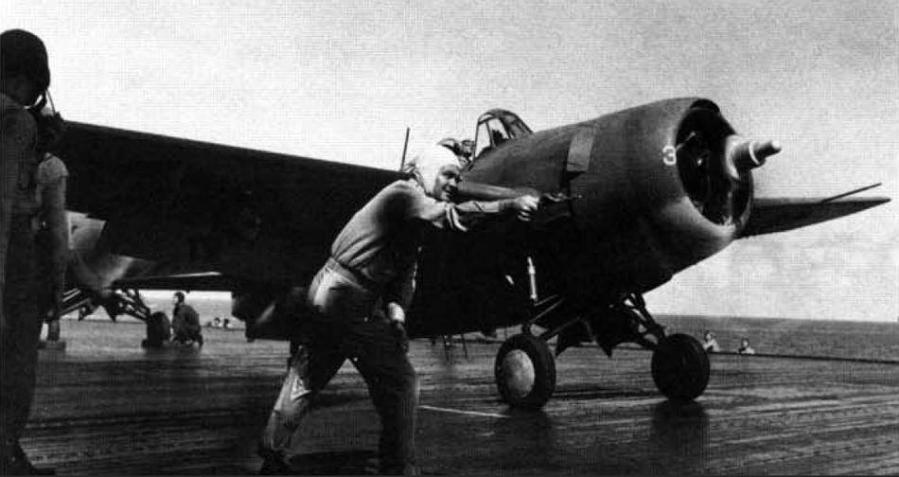
F4F-3 - VF3 -. USS Enterprise (CV-6), début/early 1942.
© US Navy (domaine public - public domain)

F4F-3 - VF2 -. USS Enterprise (CV-6), 12 mai/12 May 1942.
© US National Archives (domaine public - public domain)

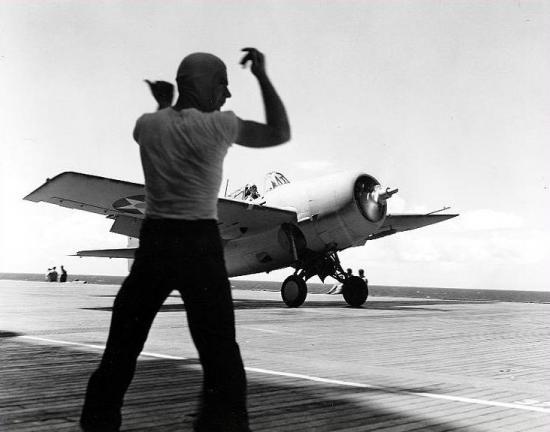
F4F-3 - Lt. John Thach,Fighter Squadron 3 (VF-3). USS Saratoga (CV-3) - Octobre 1941. October 1941.
© Naval Historical Center - (US Navy) - www.history.navy.mil
Version de série du G-36, moteur Pratt & Whitney R-1830-76 de 1200 CV pour les 100 premiers avions puis Pratt & Whitney R-1830-86 de 1200 CV pour les autres. Les 2 premiers exemplaires servent aux essais : le N° 1844 pour les mitrailleuses (février 1940) et le N°1845 pour les bombes et l'appontage (juillet 1940).
Production series of G-36, engine Pratt & Whitney R-1830-76 of 1200 HP for the first 100 units then Pratt & Whitney R-1830-86 of 1200 HP for the others.The first 2 units are used for tests: #1844 for the machine-guns (February 1940) and #1845 for the bombs and the aircraft-carrier landing (July 1940).
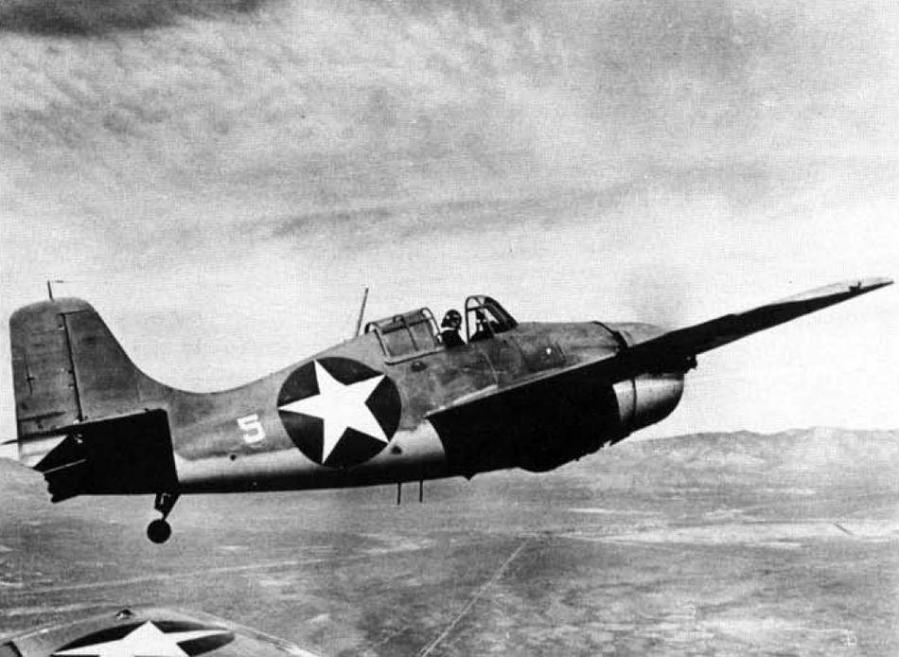
Grumman F4F-3
Les deux antennes sous le fuselage sont pour le récepteur radio de navigation ZB-3 et le récepteur radio AN-ARR-2
The two antennas under the fuselage are for the ZB-3 navigational radio receiver and AN-ARR-2 radio receiver
© Grumman Aircraft Corporation
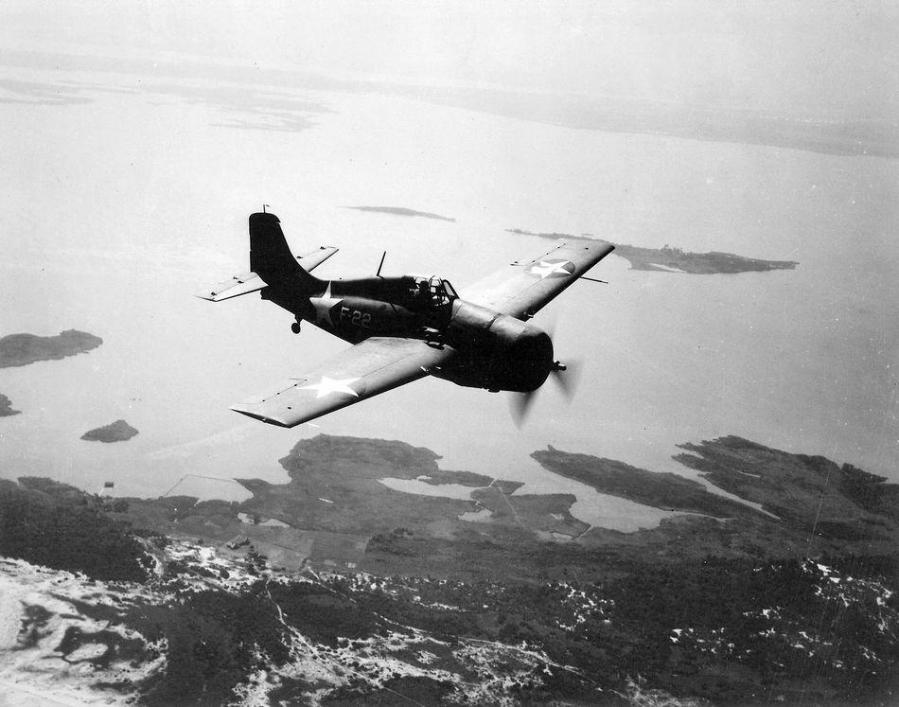
Grumman F4F-3
Une caméra 35 mm est installée sur l'emplanture de l'aile droite pour l'entraînement au mitraillage
A 35 mm gun camera is mounted on the starboard wing root for gunnery training
© Grumman Aircraft Corporation
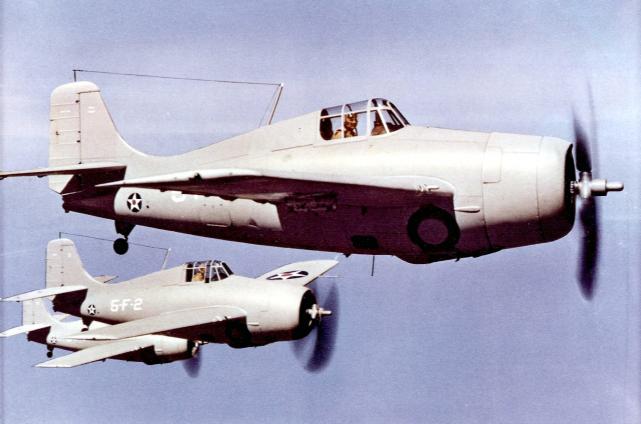 F4F-3 - VF-5 - 1941.
F4F-3 - VF-5 - 1941.
© National Museum of Naval Aviation - www.navalaviationmuseum.org
Les F4F-3 avaient 4 mitrailleuses Colt-Browning 0.5 pouces (12,7 mm) dans les ailes (sauf les deux premiers modèles 1844 et 1845 qui avaient 2 x 7,7 mm dans le capot et 2 x 12,7 mm dans les ailes). 285 exemplaires (N° 1844, 1845, 1848/1896, 2512/2538, 3856/3874, 3970/4057 et 12230/12329.
The F4F-3 had 4 machine-guns Colt-Browning 0.5 inches (12.7 mm) in the wings (except the first two models 1844 and 1845 which had 2 x 0.3 inches (7.62 mm) on the hood and 2 x 0.5 inches (12.7 mm) in the wings). 285 units (#1844,1845,1848/1896, 2512/2538, 3856/3874, 3970/4057 and 12230/12329).
XF4F-5
Deux prototypes (F4F-3 n°1846 et 1847) utilisés pour les tests de moteur Wright R-1820-40, avril 1940.
Two prototypes (F4F-3 #1846 and 1847) used for the tests of engine Wright R-1820-40, April 1940.
Martlet I (G-36A)
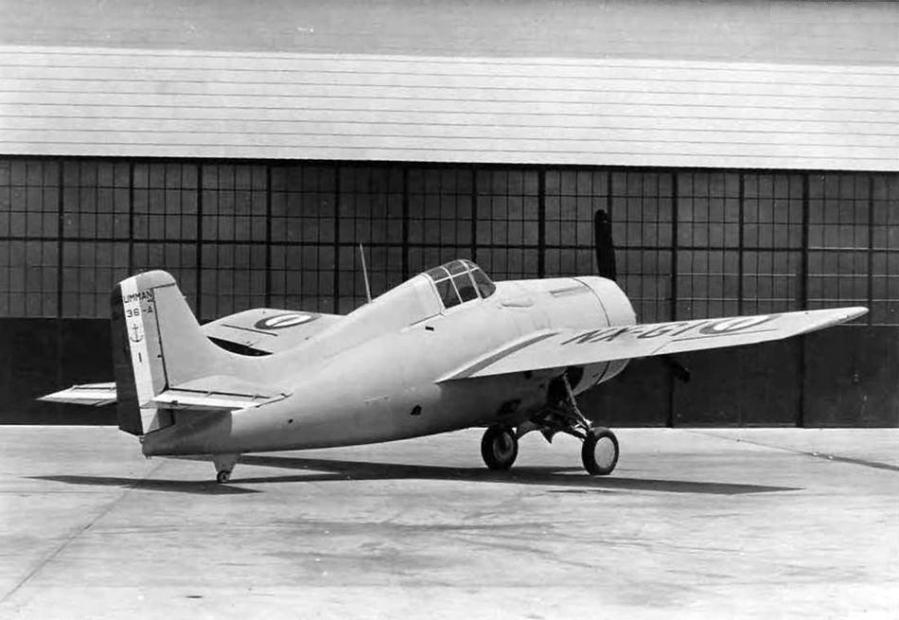
Grumman G-36 A
Le 1er G-36A pour l'Aéronavale française - The 1st G-36A for the French Aeronaval © Grumman Aircraft Corporation
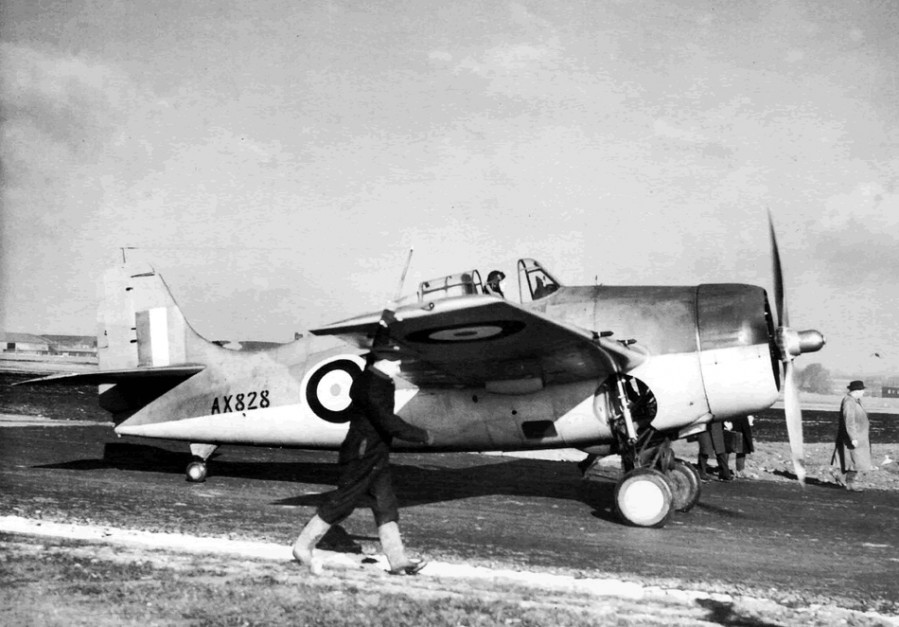
Martlet Mk I 'AX828', Ecosse 1942 - Scotland 1942
Photo : auteur inconnu - author unknown
Version de série, moteur R-1820-60 de 1 200 CV, 4 mitrailleuses de 12,7 mm dans les ailes, ailes fixes. 81 (ou 85 modèles), initialement commandés par l'Aéronavale française, furent envoyés à la Royal Navy à partir de juillet 1940.
Production series, engine R-1820-60 of 1 200 HP, 4 machine-guns of 12.7 mm in the wings, fixed wings. 81 (or 85 units), initially ordered by the French Aeronaval, were shipped to the Royal Navy in July 1940.
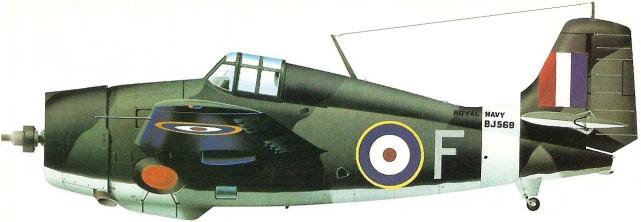
Martlet I - Squadron 804, Fleet Air Arm - Mars 1941 - March 1941
artiste inconnu - artist unknown
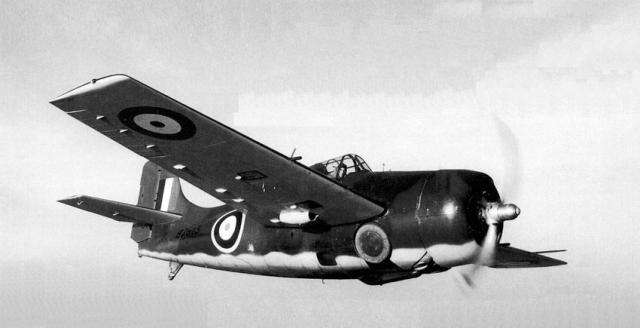
Martlet Mk I 'BJ513', Squadron 804, Fleet Air Arm © US NARA (domaine public - public domain)
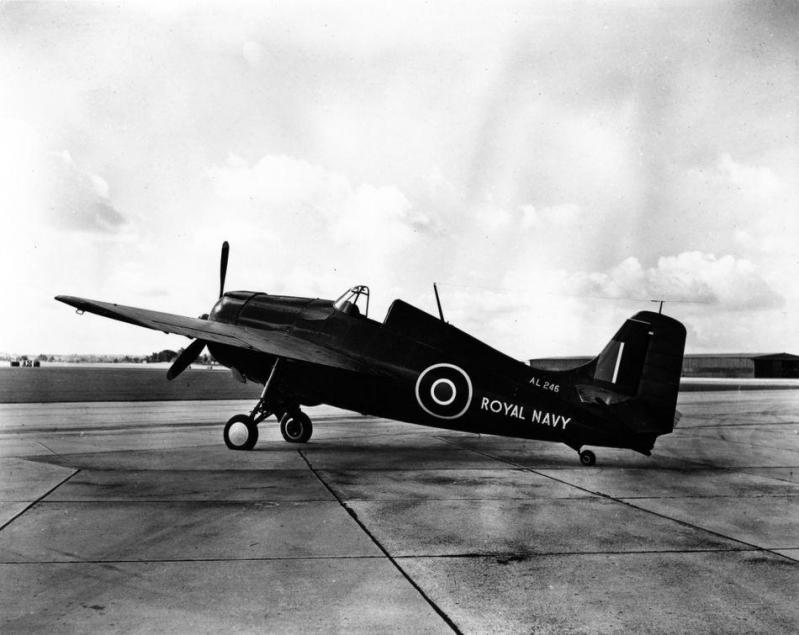
Martlet Mk I 'AL246'
Le dernier survivant des Martlet de la Fleet Air Arm, exposé au FAA Museum de Yeovilton, Angleterre
The only remaining Martlet of the Fleet Air Arm exhibited in the FAA Museum at Yeovilton, England
© Grumman Aircraft Corporation
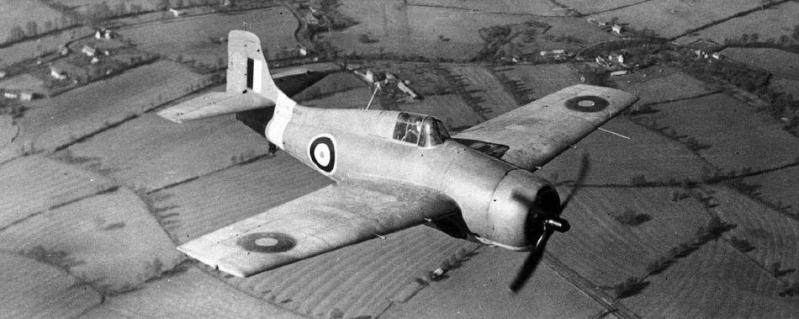
Martlet Mk I 'AL257', No 759 Squadron ou/or No 778 Squadron - Angleterre/England, 1940
© FAA Museum
XF4F-6
Novembre 1940, F4F-3 n°7031 dont le moteur fut remplacé par le Pratt&Whitney Twin Wasp R-1830-90. Il s'écrasa en mai 1942.
November 1940, F4F-3 #7031 whose engine was replaced by Pratt&Whitney Twin Wasp R-1830-90. It crashed in May 1942.
F4F-3A (G-36B)
Basé sur le XF4F-6, moteur Pratt & Whitney R-1830-90 de 1200 CV. 65 fabriqués pour l'USN/USMC (N° 3905/3969). Selon une autre source, 95 furent fabriqués (BuAer 3875 à 3969).
Based on the XF4F-6, engine Pratt & Whitney R-1830-90 of 1200 HP. 65 manufactured for the USN/USMC (#3905/3969). According to another source, 95 units were built (BuAer 3875 to 3969).
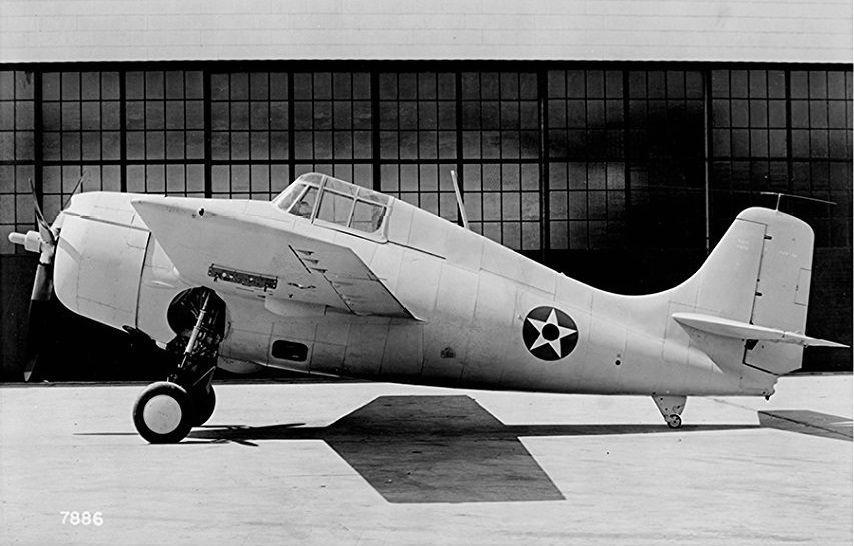
Grumman F4F-3A Wildcat BuNo 3905, Avril/April 1941 © Grumman Aircraft Corporation
Mais les numéros 3875 à 3904 furent commandés par l'US Navy, puis furent vendus à la Grèce mais livrés à Suez et repris par la Royal Navy comme Martlet III, et les BuAer furent remplacés par les codes anglais AX724/AX747, AX753/AX754, AX761 et HK840/HK842.
But the BuAer 3875 to 3904 were ordered by the US Navy, then were sold to Greece but delivered to Suez and diverted to the Royal Navy as Martlet III, and BuAers were replaced by UK serials AX724/AX747, AX753/AX754, AX761 and HK840/HK842.
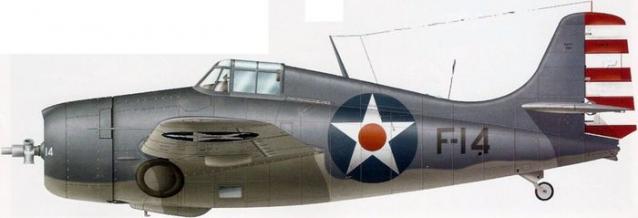
F4F-3 (BuAer 3914) - Lieutenant (jg) Wilmer E. Rawie, Fighting Six, USS Enterprise (CV-6)
Taroa (Marshall), 1er février 1942. 1st February, 1942.
© Jean-Marie Guillou
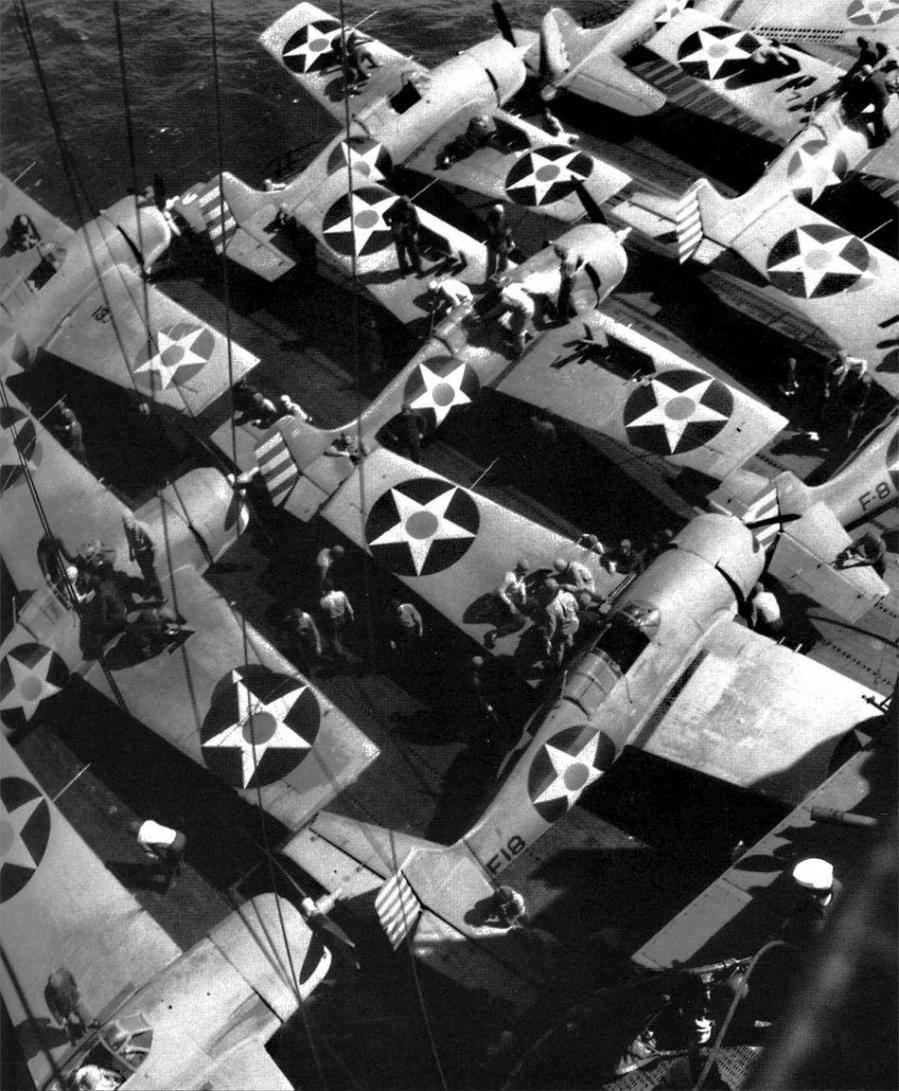
F4F-3A (?) - VF-6, USS Enterprise (CV-6)
Après un raid sur l'Ïle Marcus - After a raid over Marcus Island.
Photo : US National Archives (domaine public - public domain)
Martlet II
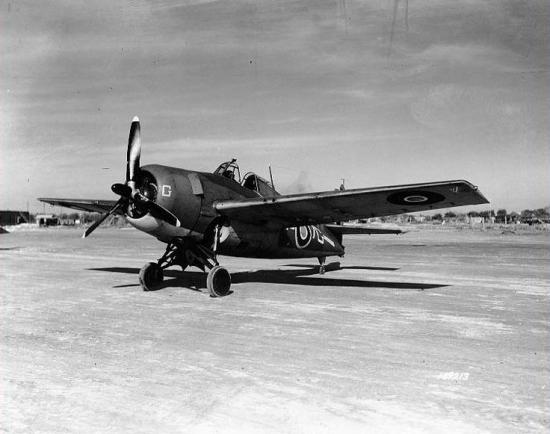
Martlet II - Oran La Senia - Algérie, Décembre 1942. Algeria, December 1942.
© Naval Historical Center - (US Navy) - www.history.navy.mil
100 F4F-3A en service dans la Royal Navy (les 10 premiers à ailes fixe, les suivants à ailes repliable).
100 F4F-3A used in the Royal Navy (the first 10 with fixed wings, the following with folding wings)
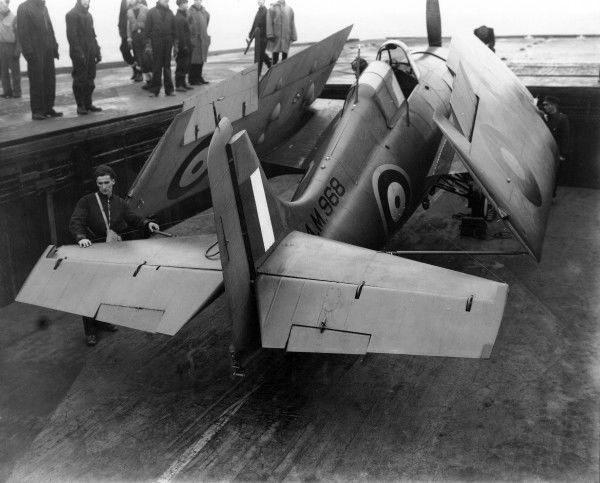
Grumman Martlet II (AM968), 881 Squadron - HMS Illustrious, 1942
Avec ailes repliable - with foldable wings © US Navy (domaine public - public domain)
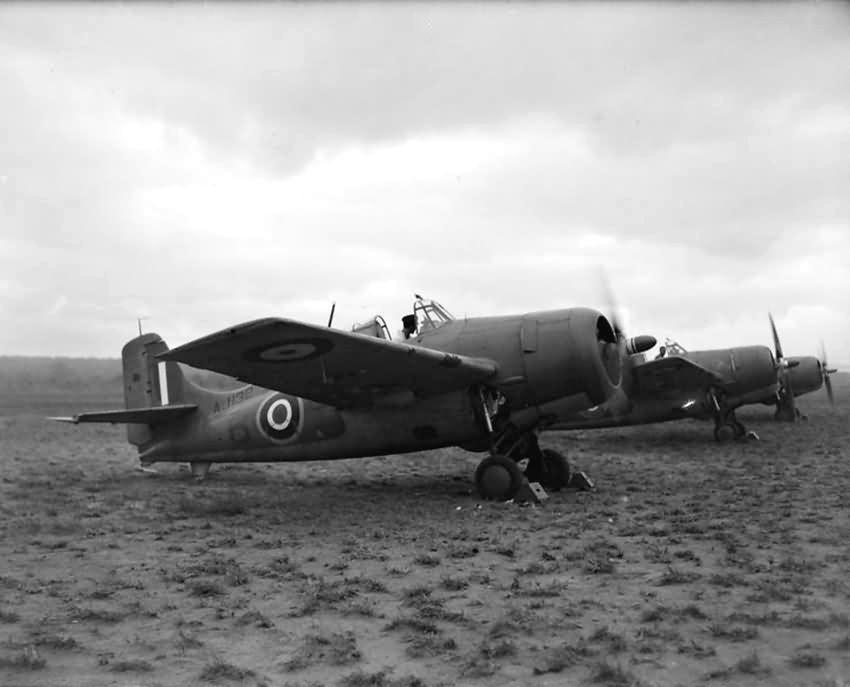
Martlet Mk II 'AJ132', No 881 Squadron - Angleterre/England
© FAA Museum

XF4F-4 (BuAer 1897)
F4F-3 équipé d'ailes repliables hydrauliquement fabriqué en avril 1941.
F4F-3 fitted with foldable hydraulic wings built in April 1941.
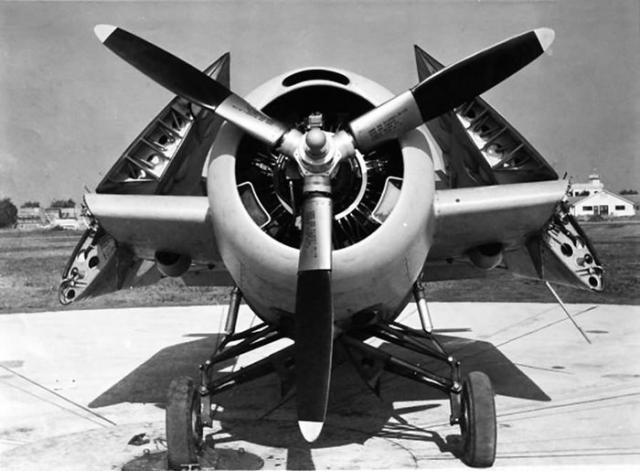
Grumman XF4F-4 - © USAF (domaine public - public domain)
Martlet III
30 F4F-3A destinés à la Grèce et mis en service dans la Royal Navy (N° 3875/3904).
30 F4F-3A ordered by Greece but shipped to the Royal Navy (# 3875/3904).
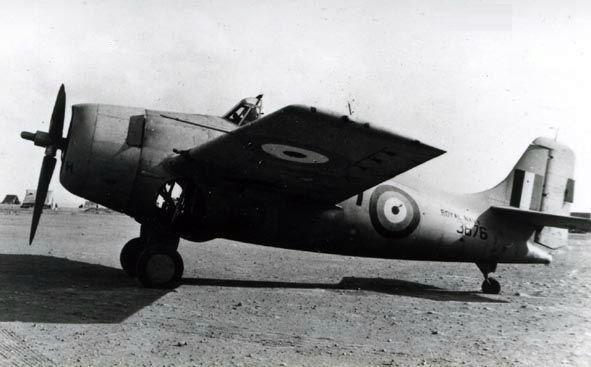
Martlet III, (US Navy BuNo 3676) Royal Navy Fighter Unit - désert de l'Ouest, 1941 - Western desert, 1941 © Fleet Air Arm
F4F-4
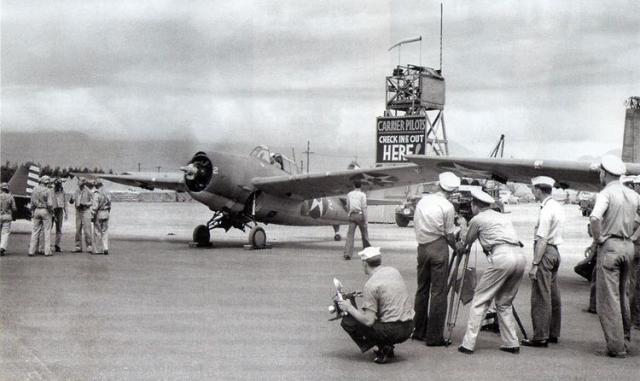
F4F-4 - 1943
Un F4F-4 utilisé pour une production hollywoodienne sur les F4F-3 de la VF-3
A F4F-4 used for an Hollywood production on F4F-3s from VF-3.
© US Navy (domaine public - public domain)

F4F-4 Wildcat
Réglage des mitrailleuses Browning calibre .50 peu après le débarquement en Afrique du Nord (Opération Torch, novembre 1942)
Adjustment of .50 caliber Browning machine guns shortly after the landing in North Africa (Operation Torch, November 1942).
© National Air and Space Museum
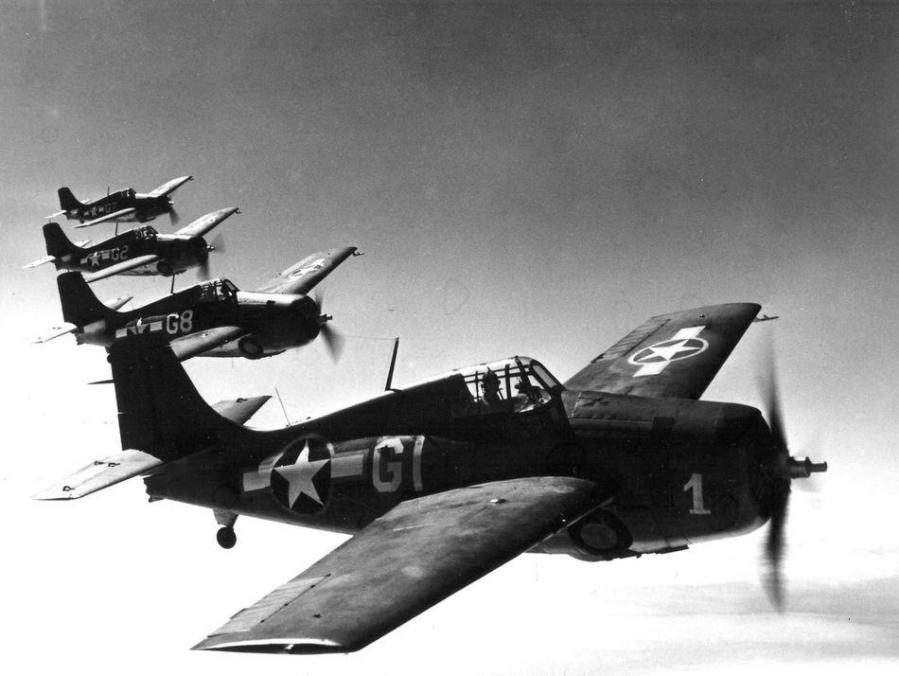
F4F-4 - Trainer Cherry Point, Caroline du Nord/North Carolina - USA - 1943
© US Navy (domaine public - public domain)
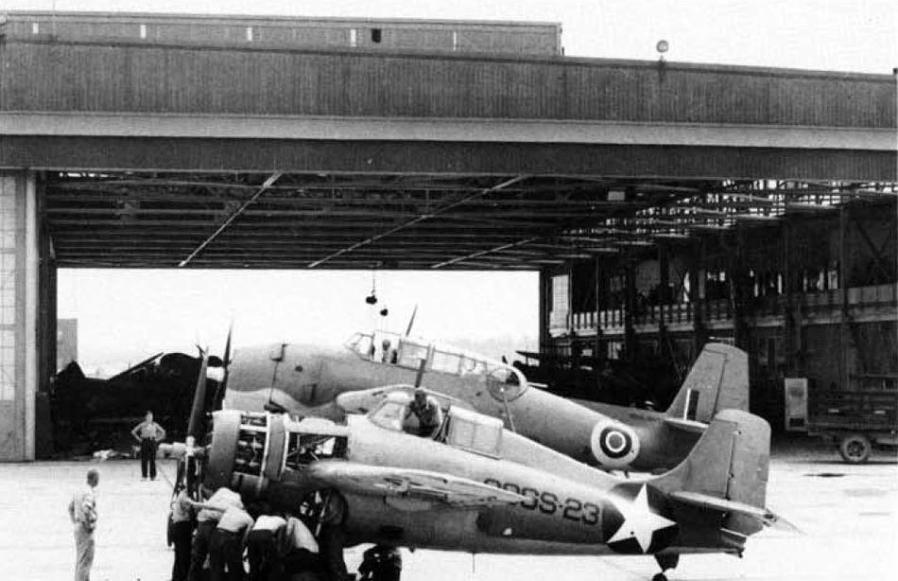
F4F-4, Armed Scouting Squadron (VGS) 30, Nas Norfolk
Des mécaniciens étudient le moteur, septembre 1942 - Mechanics study the engine, September 1942
© US Navy (domaine public - public domain)
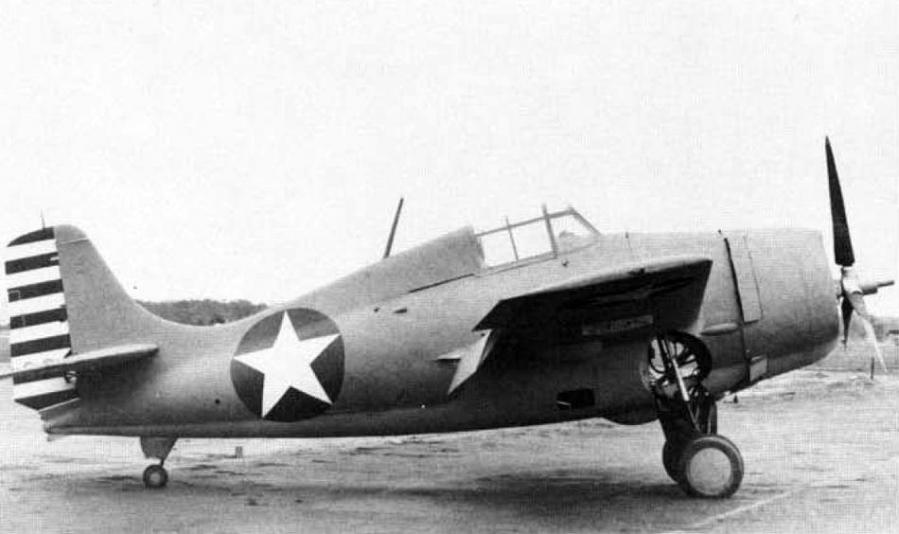
F4F-4 BuNo 5262
Le 233e F4F-4 utilisé par Grumman pour des essais de volets sur toute l'envergure de l'aile
The 233rd F4F-4 built and used by Grumman for testing full span flaps.
© US National Archives (domaine public - public domain)
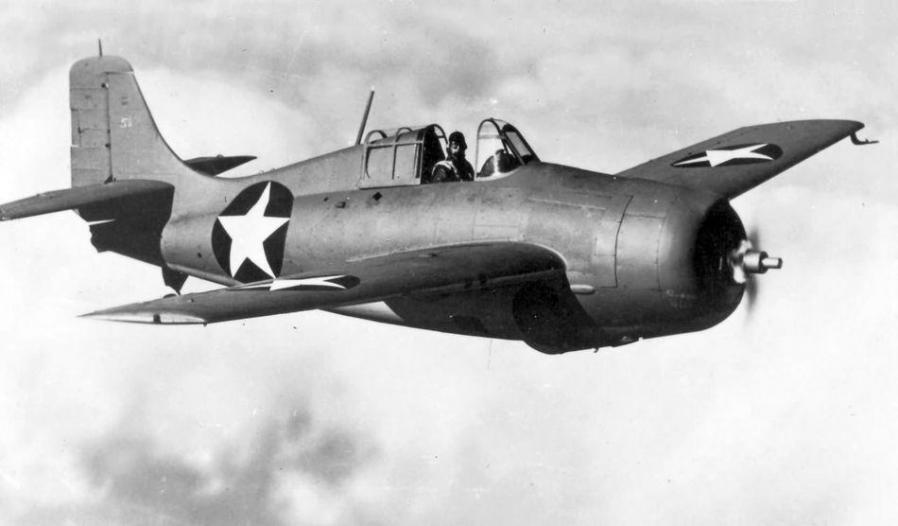
F4F-4
Avec la nouvelle cocarde après le 15 mai 1942. With the new insignia after 15 May 1942
© Grumman Aircraft Corporation
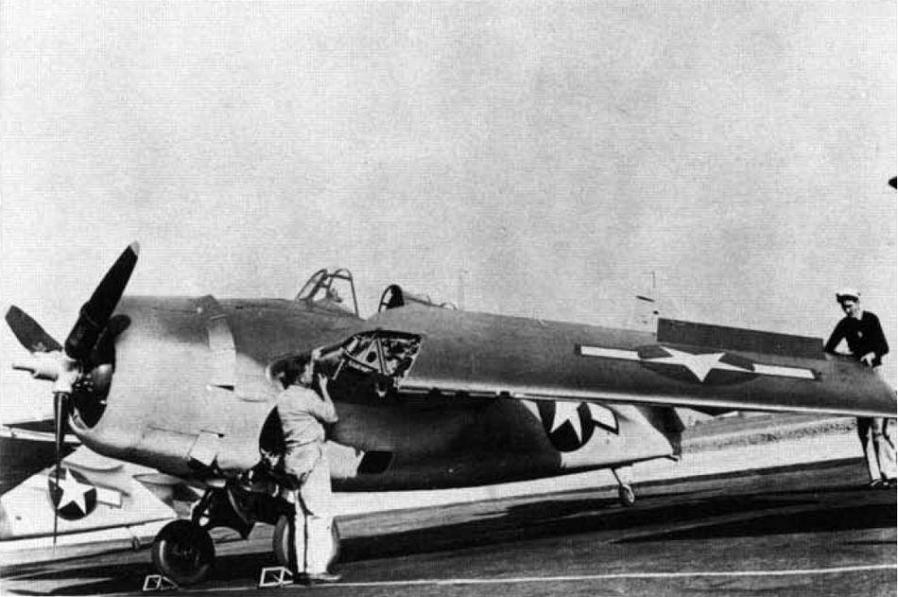
F4F-4.
© US National Archives (domaine public - public domain)
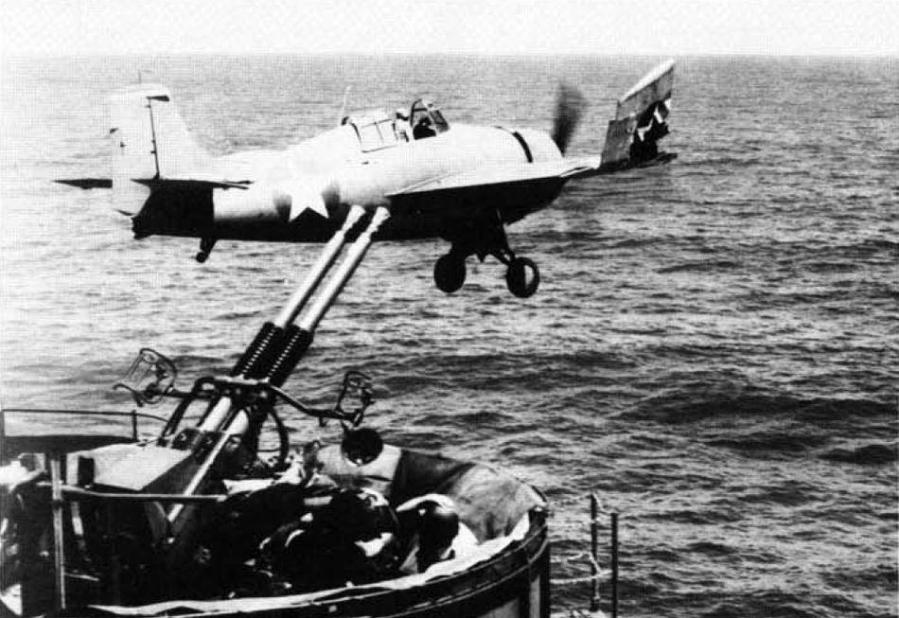
F4F-4
Ce Wildcat touche le canon Bofors 40 mm avec l'aile droite au décollage. Le pilote sera récupéré par un destroyer de surveillance.
This Wildcat strucked the 40 mm Bofors gun on take off. The pilot was rescued by a pane guard destroyer.
© US National Archives (domaine public - public domain)
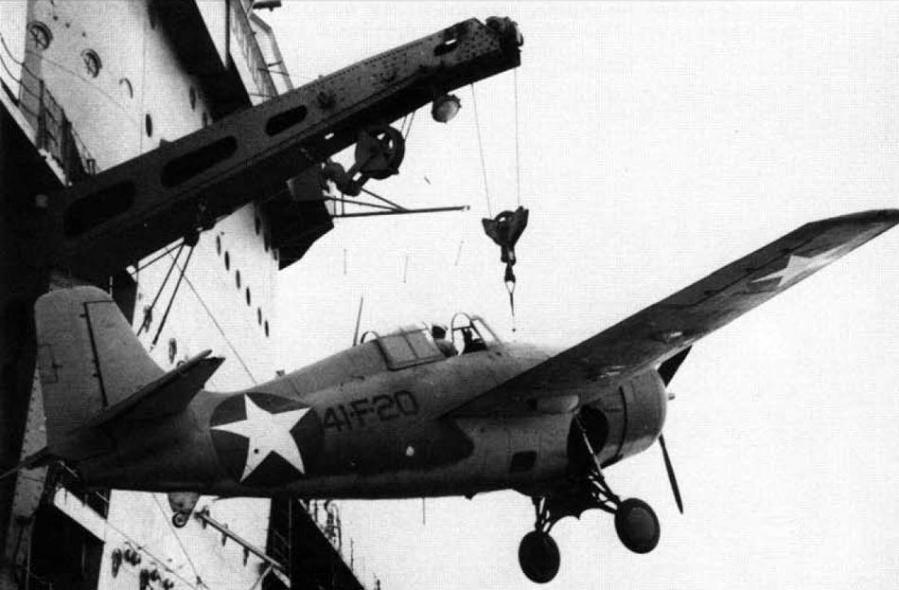
F4F-4 - VF-41 - USS Ranger (CV-4), NAS Norfolk, Virginie, août 1942 - Virginia, August 1942 © US National Archives (domaine public - public domain)
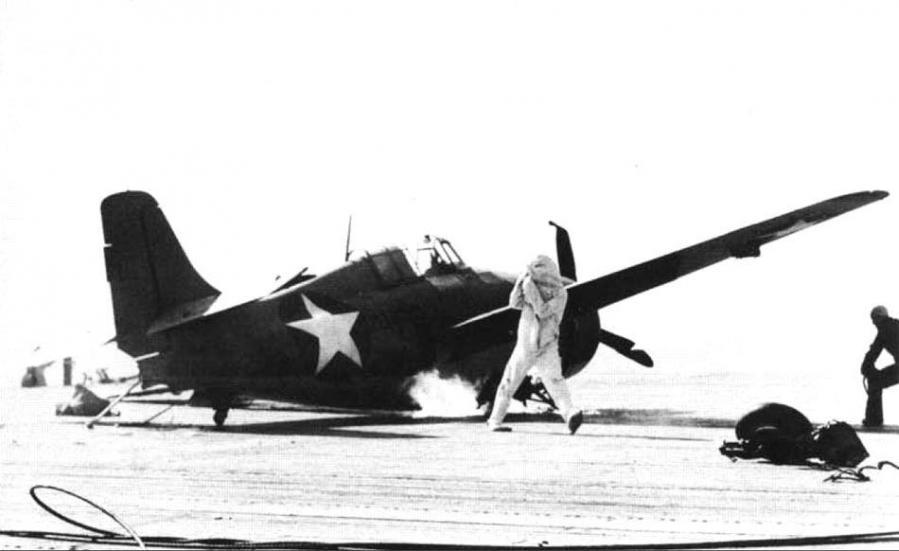
F4F-4 - VF-41 - USS Ranger (CV-4), Crash avec départ de feu, juin 1942 - Crash and fire start, June 1942 © US National Archives (domaine public - public domain)
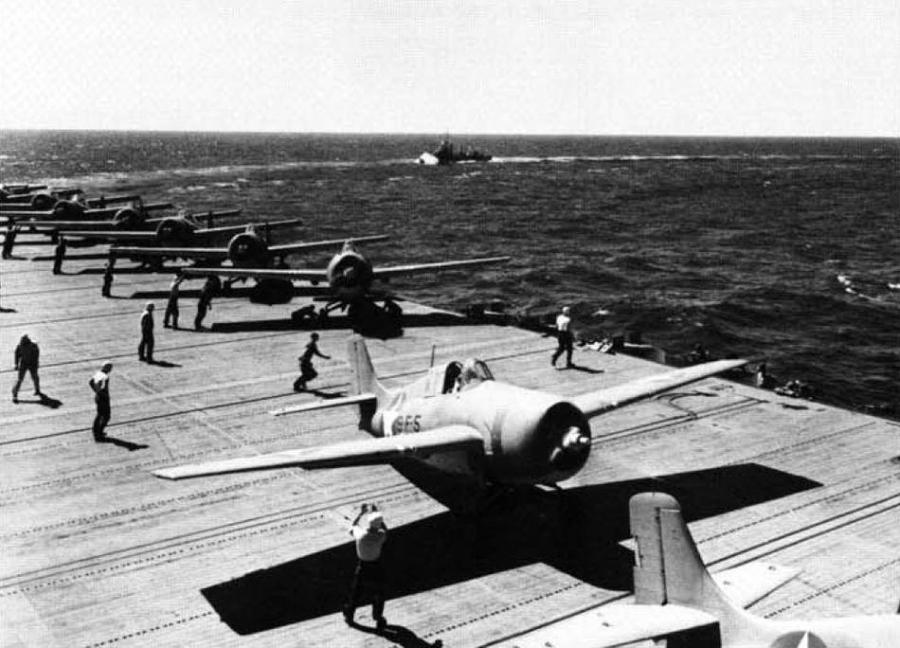
F4F-4 - VF-9 - USS Ranger (CV-4) - Août 1942 - August 1942 © US National Archives (domaine public - public domain)
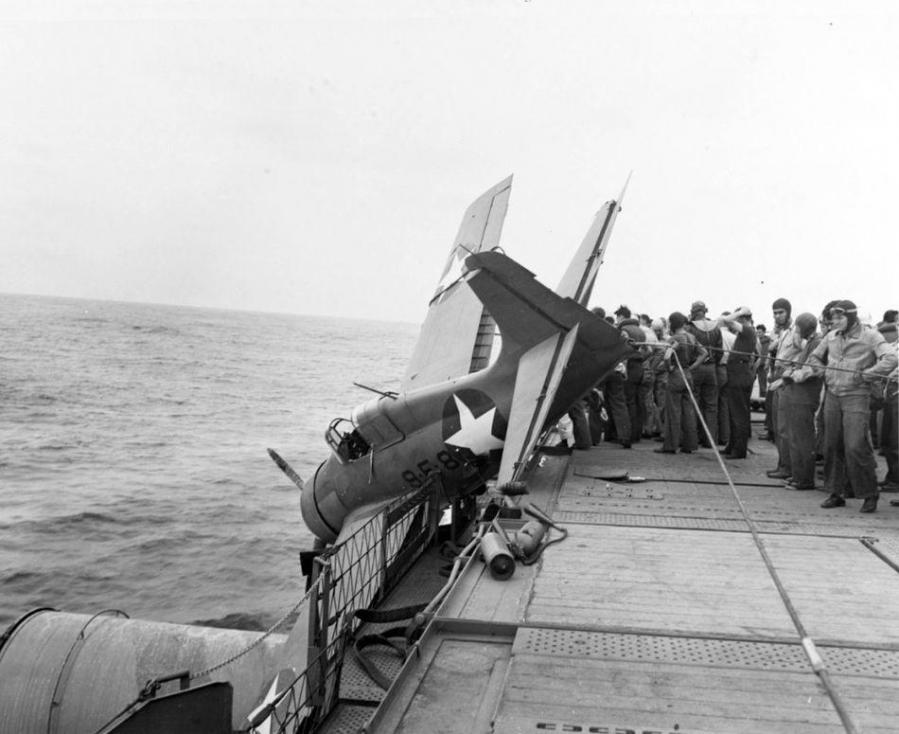
F4F-4 - VF-9 - USS Ranger (CV-4)
L'équipage arrose le moteur et retient l'avion, 25 Août 1942 - The crew sprays water on the engine and holds the aircraft, 25 August 1942
© US Navy (domaine public - public domain)
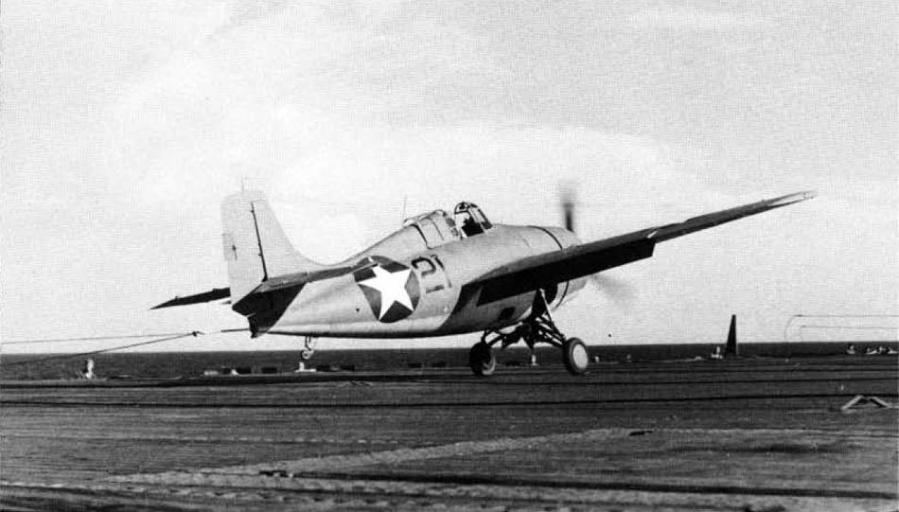
Grumman Wildcat - USS Ranger (CV-4) - 15 octobre 1942 - 15 October 1942 © US National Archives (domaine public - public domain)
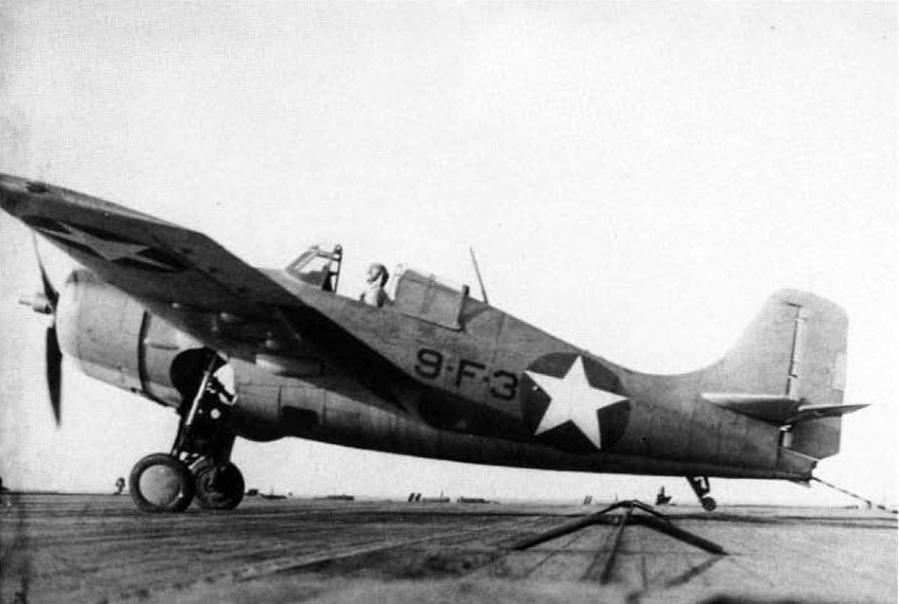
F4F-4 - VF-9 - USS Ranger (CV-4) - 22 octobre 1942 - 22 October 1942 © US National Archives (domaine public - public domain)
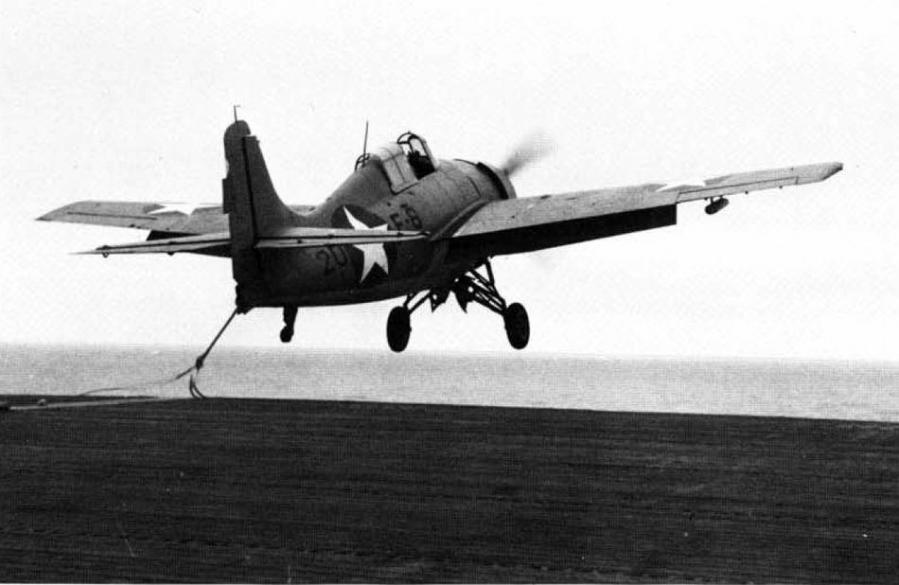
Grumman F4F-4 Wildcat, VF-20, USS Barnes (CV-4) - 26 mars 1943 - 23 March 1943
© US National Archives (domaine public - public domain)
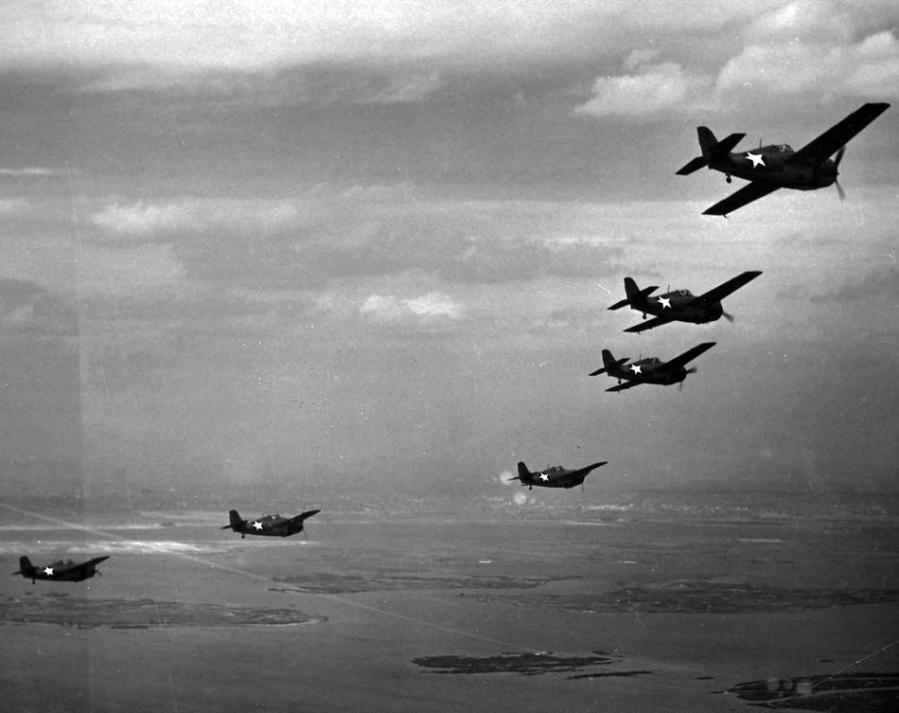
F4F-4 Wildcat, VF-24, NAS Floyd Bennett Field, New-York - 28 avril 1943 - 28 April,1943
© US Navy (domaine public - public domain)
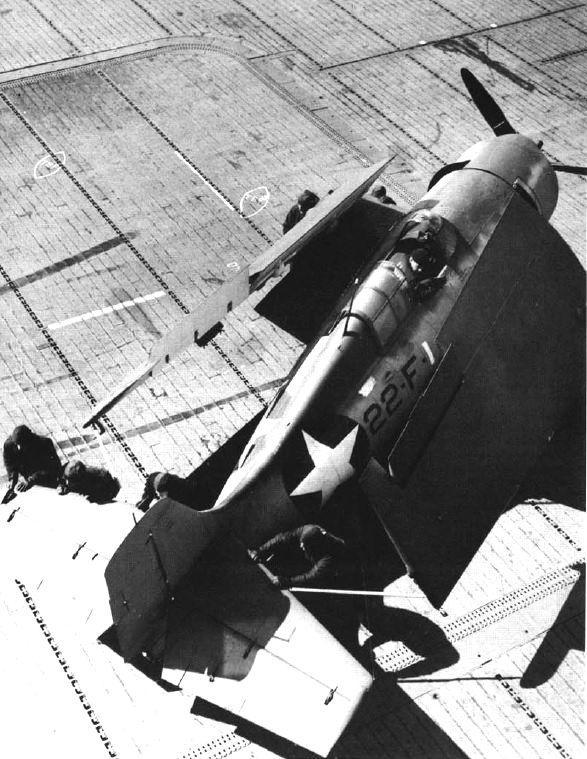
F4F-4 Wildcat, VF-22, USS Independence (CVL-22) - 30 avril 1943 - 30 April,1943
© US Navy (domaine public - public domain)
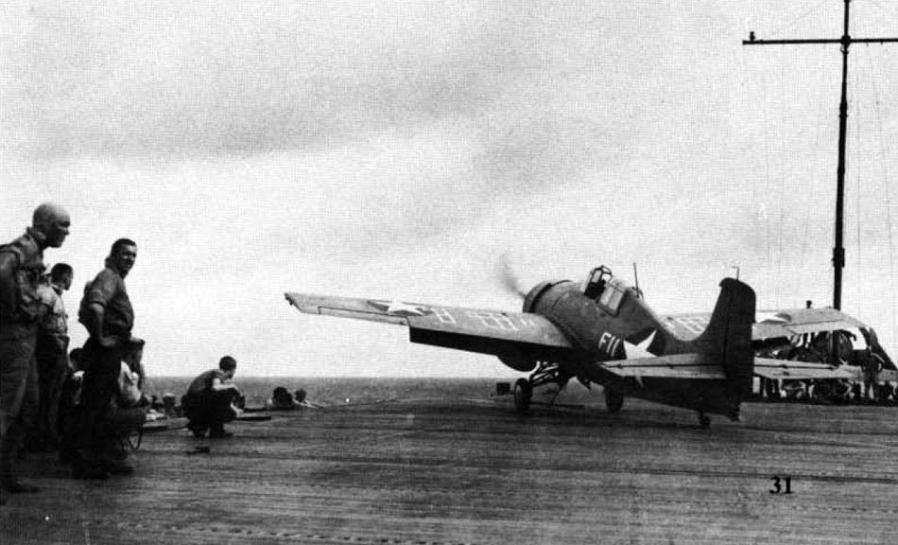
F4F-4 Wildcat, USS Long Island - Mars 1943 - March 1943.
© National Air and Space Museum
Deuxième version de série, moteur R-1830-86 de 1 200 CV, 6 mitrailleuses de 12,7 mm dans les ailes, ailes repliables manuellement, novembre 1941. L'intérêt des ailes repliables était de pouvoir mieux stocker les avions et de les remonter deux par deux sur l'ascenseur.
Second production series, engine R-1830-86 of 1 200 HP, 6 machine-guns of 12.7 mm in the wings, manually foldable wings, November 1941. The interest of foldable wings was to store more easyly the aircrafts and to lift them two by two with the elevator.
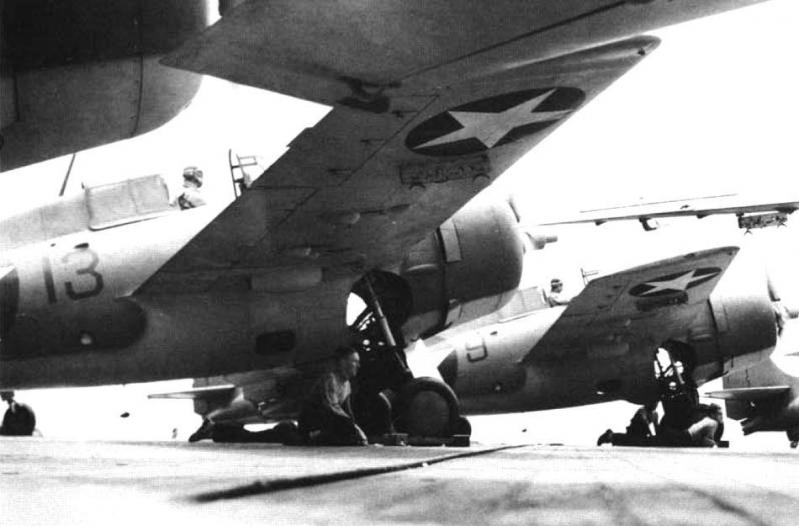
F4F-4 Wildcat, Des hommes attendent sous les ailes pour retirer les cales - 2Aircraft handlers wait under the wings to remove wheel chocks
© US Navy (domaine public - public domain)
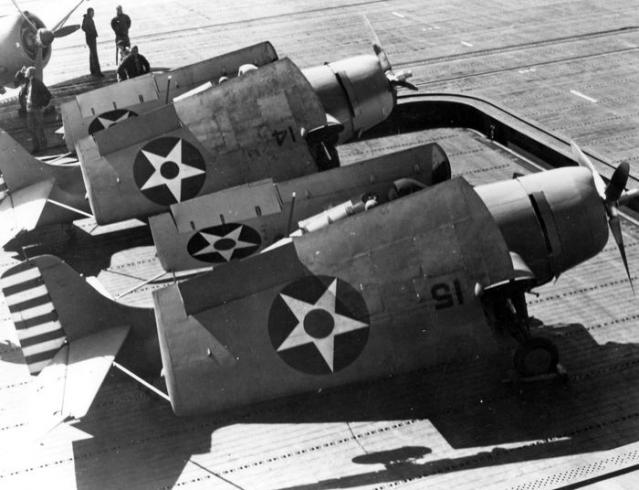
F4F-4 - VF-6, USS Enterprise (CV-6). Raid Doolittle, avril 1942. Doolittle raid, April 1942.
Photo No. 1996.488.272.006 © Robert L. Lawson Photograph Collection - U.S. Navy National Museum of Naval Aviation
(domaine public - public domain)
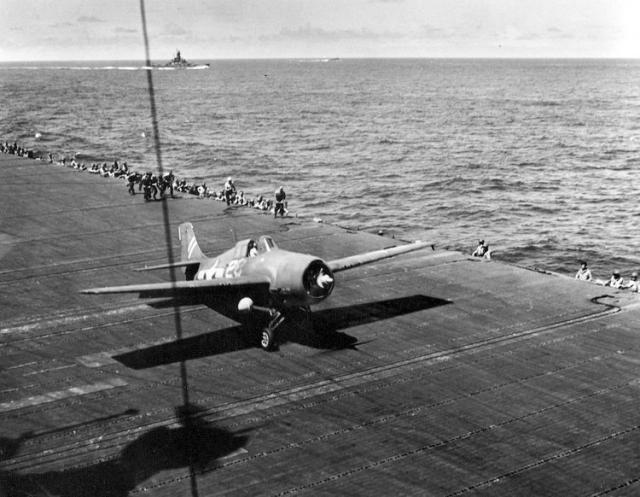
© US Navy (domaine public - public domain)
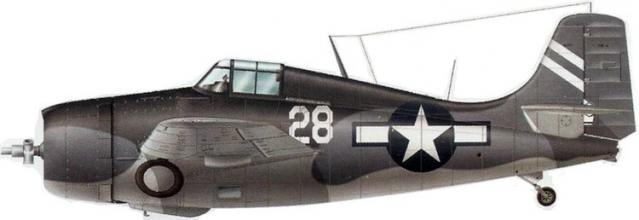
© Jean-Marie Guillou
Grumman F4F-4 Wildcat, VC 39, USS Liscome Bay (CVE-56)
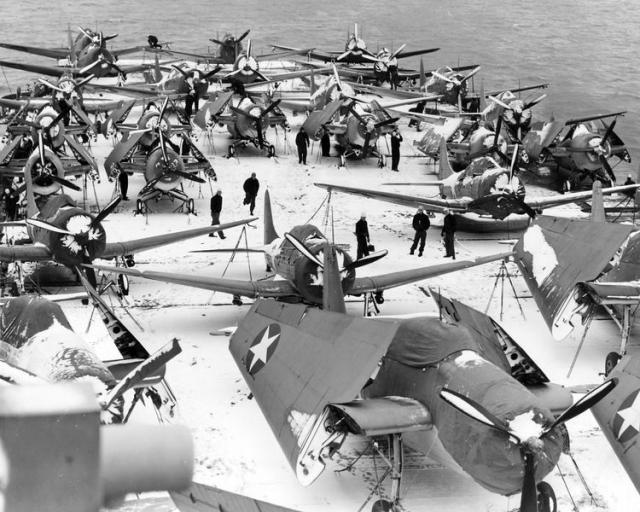
Grumman F4F-4 Wildcat, VF-41, USS Ranger (CV-4)
Sous la neige avec des Avengers (VT-4) et des Dauntless (VB-41), Atlantique Nord, 29 juin 1943
Under the snow with Avengers (VT-4) and Dauntless (VB-41), North Atlantic, 29 June 1943
© US National Archives and Record Administration (domaine public - public domain)
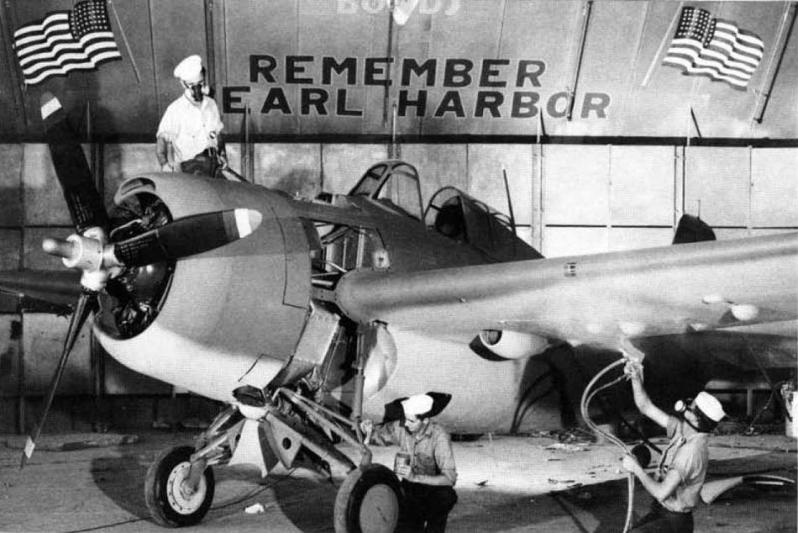
Grumman F4F-4 Wildcat
Repeint pour être utilisé au rallye de collecte de bons de guerre en septembre 1942
Re-painted for bieng used in a war bond rally in September 1942
© US Navy (domaine public - public domain)
Martlet IV
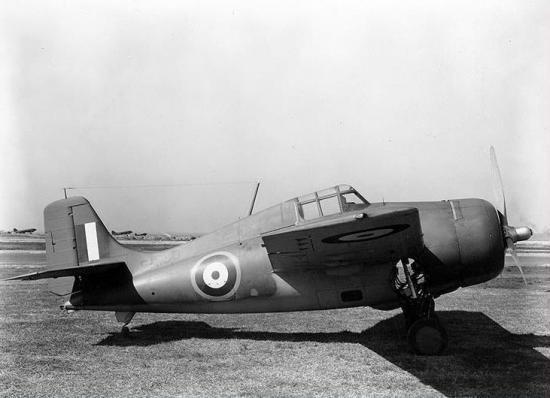
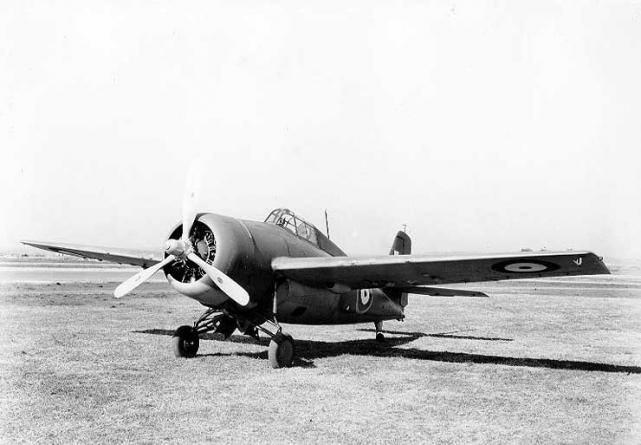
Martlet IV (FN 100) - Naval Air Station, Anacostia, Washington D.C. Avril 1942. April 1942.
© Naval Historical Center - (US Navy) - www.history.navy.mil
220 F4F-4 en service dans la Royal Navy.
220 F4F-4 used in the Royal Navy.
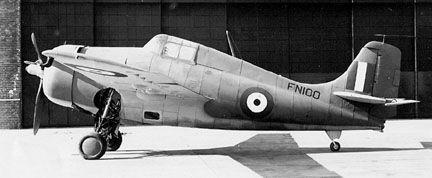
Martlet IV (FN 100) © Grumman Aircraft Corporation
F4F-7
Version de reconnaissance, avec capacité des réservoirs de 2590 litres, pilote automatique, 100 commandés, 21 produits (BuAer 5263 à 5283), premier vol le 30 décembre 1941.
Recognition version, with tank capacity of 2590 liters, automatic pilot system, 100 ordered, 21 manufactured (BuAer 5263 to 5283), first flight on December 30th, 1941.
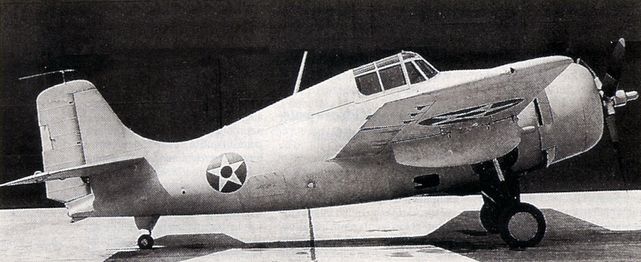
Grumman F4F-7 - © US Navy (domaine public - public domain)
XF4F-8
Prototypes (BuAer n°12228 & 1229) avec R-1820-56 de 1 250 CV, dérive agrandie, novembre 1942.
Prototypes (BuAer #12228 & 1229) with R-1820-56 of 1 250 HP, enlarged tail, November 1942.
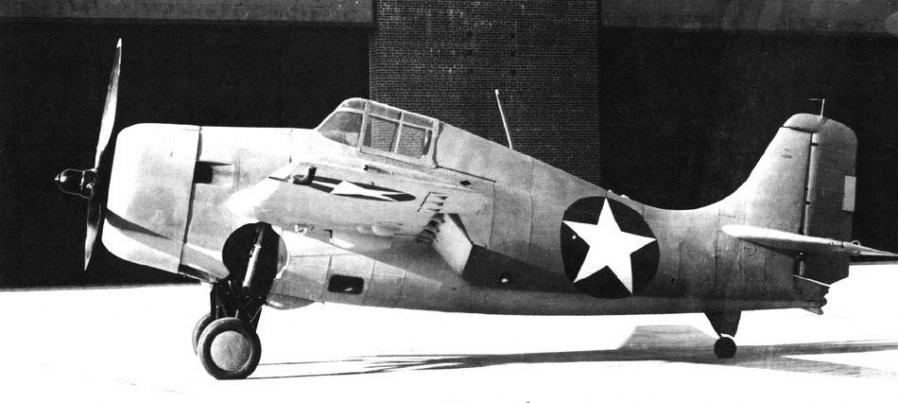
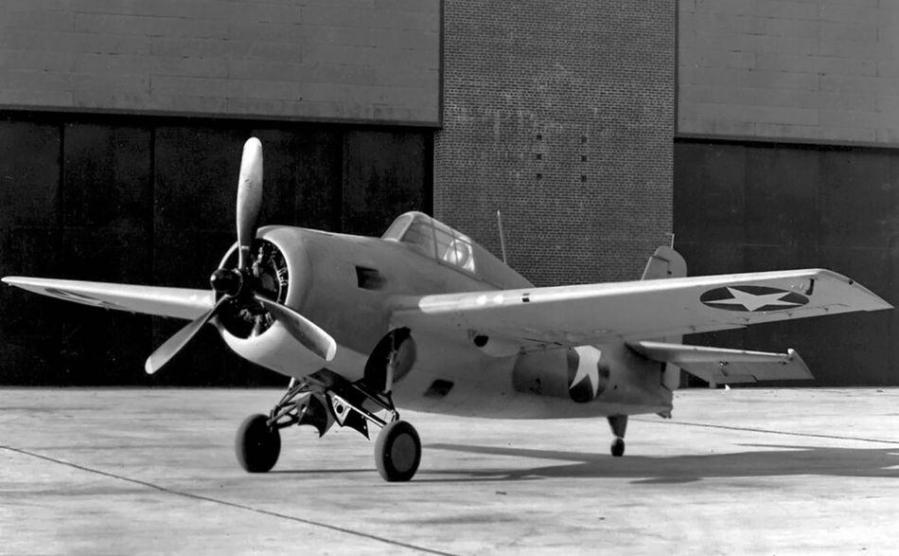
Grumman XF4F-8 (BuNo 12228), Bethpage, 12 Novembre/November 1943 - © Grumman Aircraft Engineering Corporation
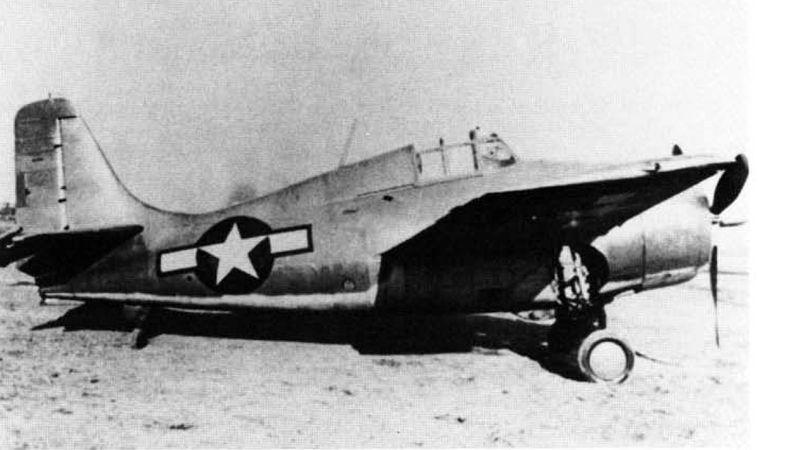
Grumman XF4F-8 (BuNo 12229) - © Grumman Aircraft Engineering Corporation
FM-1

Eastern Aircraft FM-1, VC-12- USS Core (CVE-13)
Atterrissage difficile - Bad landing
© US Navy (domaine public - public domain)
1 150 exemplaires de F4F-4 produits par Eastern Aircraft (1 060 produits selon une autre source).
1,150 units of F4F-4 manufactured by Eastern Aircraft (1,060 manufactured according to another source).
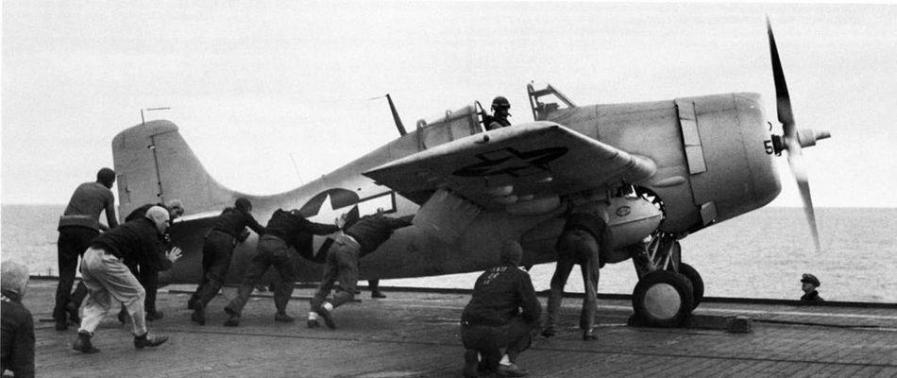
Eastern Aircraft FM-1, VGF-29- USS Santee (CVE-29)
Mise en place sur la catapulte, novembre 1943 - Handled into position on the catapult
© National archives (domaine public - public domain)
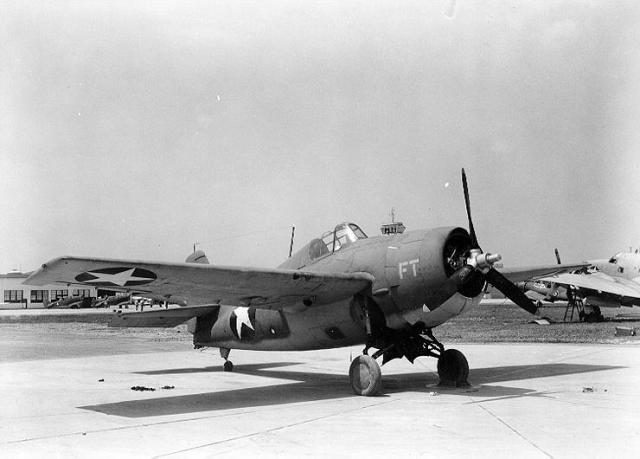
FM-1 - Naval Air Station Anacostia, Washigton D.C. - Printemps/Spring 1942 (FT = Flight Test)
© US Navy (domaine public - public domain)
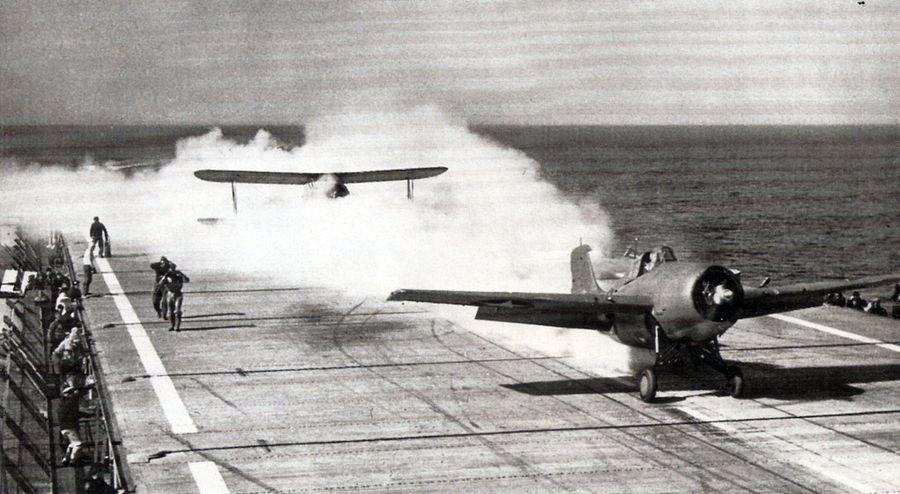
FM-1 - Décollage avec accélérateurs à poudre, mars 1944 - Taking off with powder accelerators, March 1944
© US Navy (domaine public - public domain)
 Martlet V
Martlet V
311 (ou 312) FM-1 en service dans la Royal Navy.
311 (or 312) FM-1 used in the Roral Navy.
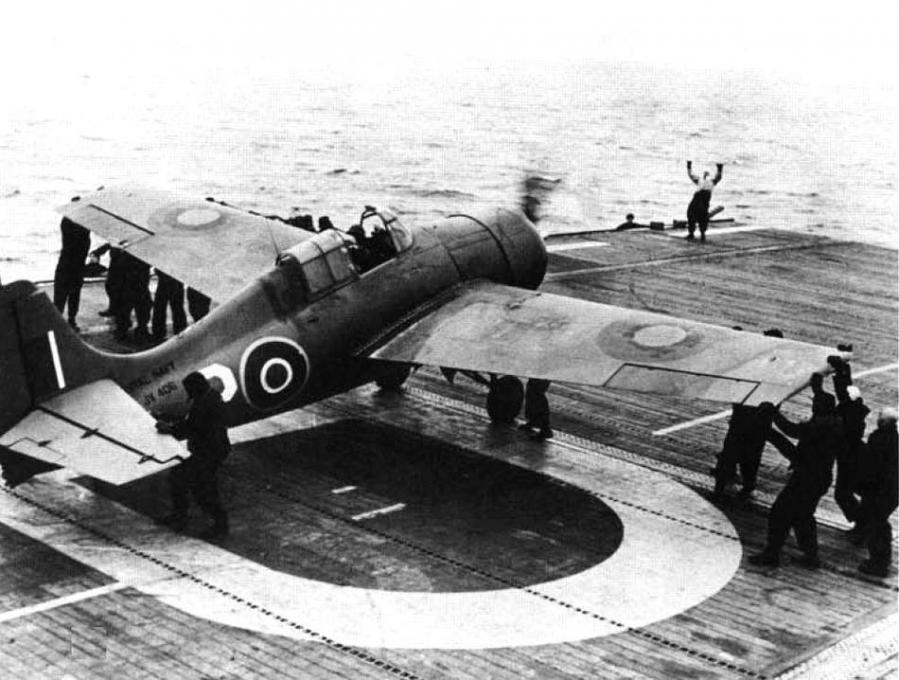
Martlet Mk V (JV406 ou/or JY406 ?), No 861 Squadron, HMS Purser, Atlantique Nord, début 1945/North Atlantic, early 1945
© FAA Museum
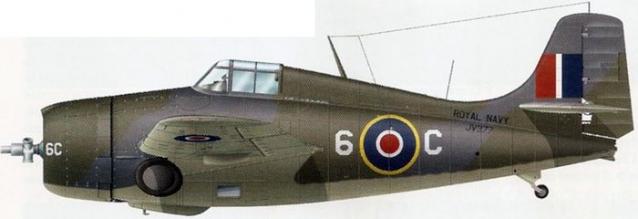
Martlet Mk V, No 822 Squadron, HMS Searcher, 1944 - © Jean-Marie Guillou
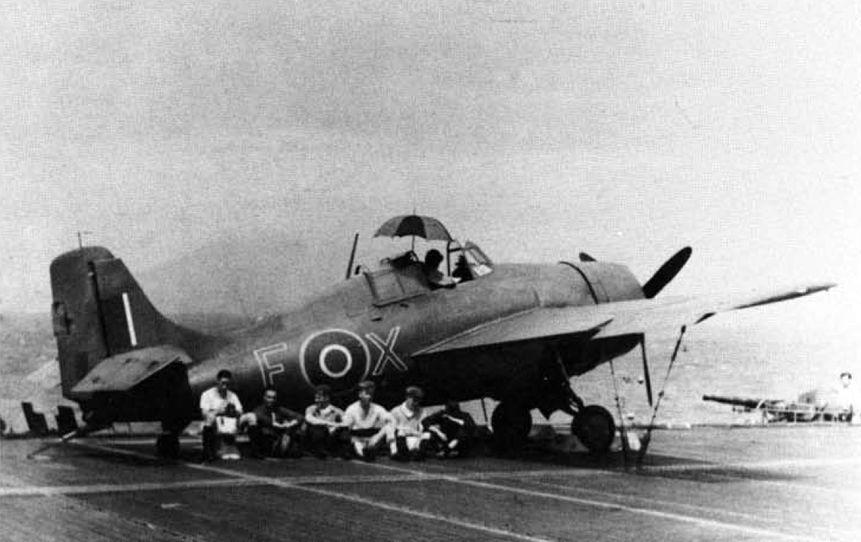
Martlet Mk V (JV394), No 842 Squadron, Lt. Dennis White (avec le parapluie, with umbrella), HMS Fencer, été/summer 1944
© FAA Museum
F4F-3S
Version modifiée du F4F-3 n° 4038 avec des flotteurs. 1er vol en février 1943. Projet abandonné.
Modified version of F4F-3 #4038 with floats. 1st flight in February, 1943. Project stopped.
XF4F-7
2 prototypes Grumman du FM-2 de General Motors avec R-1820-56 de 1 350 CV, empennage vertical agrandi de 30%.
2 prototypes Grumman of General Motors FM-2 with R-1820-56 of 1 350 HP, enlarged vertical tailplane by 30%.
FM-2
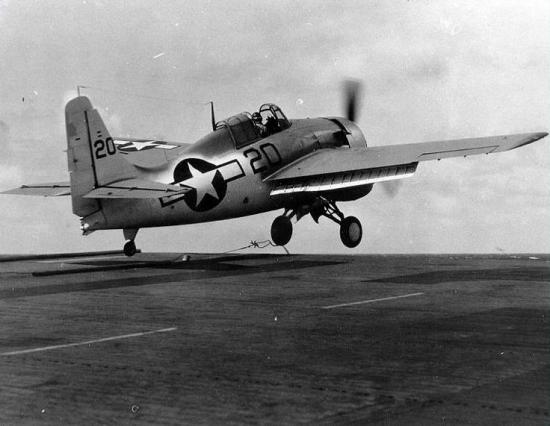
General Motors FM-2- USS Core (CVE-13) - Atlantique Nord, avril 1944. Northern Atlantic, April 1944.
© Naval Historical Center - (US Navy) - www.history.navy.mil
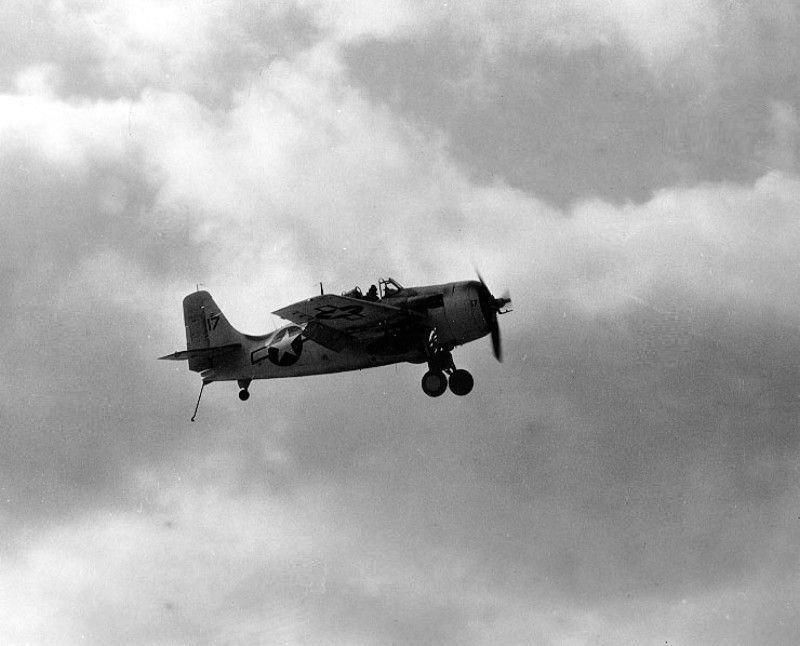
Eastern Aircraft FM-2, VC-12 - USS Core (CVE-13) - Atlantique Nord, 12 avril 1944. Northern Atlantic, 12th April 1944.
© National Archives (domaine public - public domain)
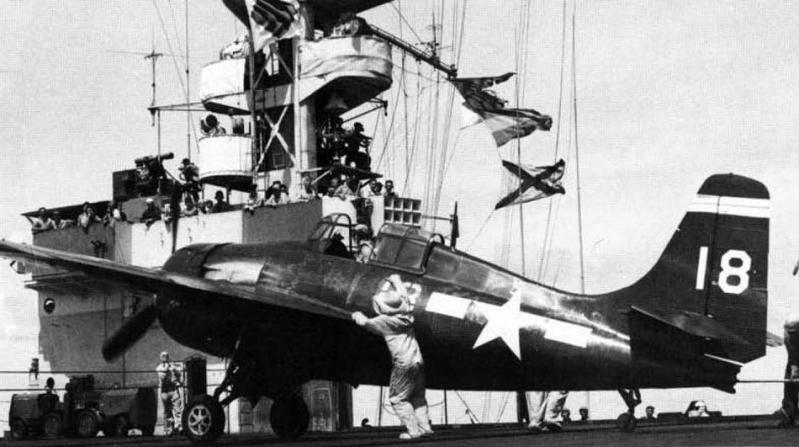
Eastern Aircraft FM-2, VC-20 - USS Kandashan Bay (CVE-76).
© National Archives (domaine public - public domain)
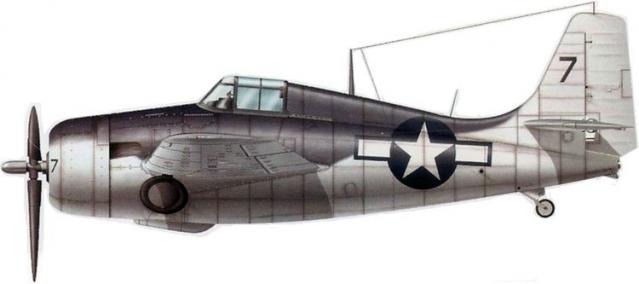
General Motors FM-2 USS Guadalcanal (CVE-60) - Océan Atlantique, juin 1944. Atlantic ocean, June 1944
© Jean-Marie Guillou
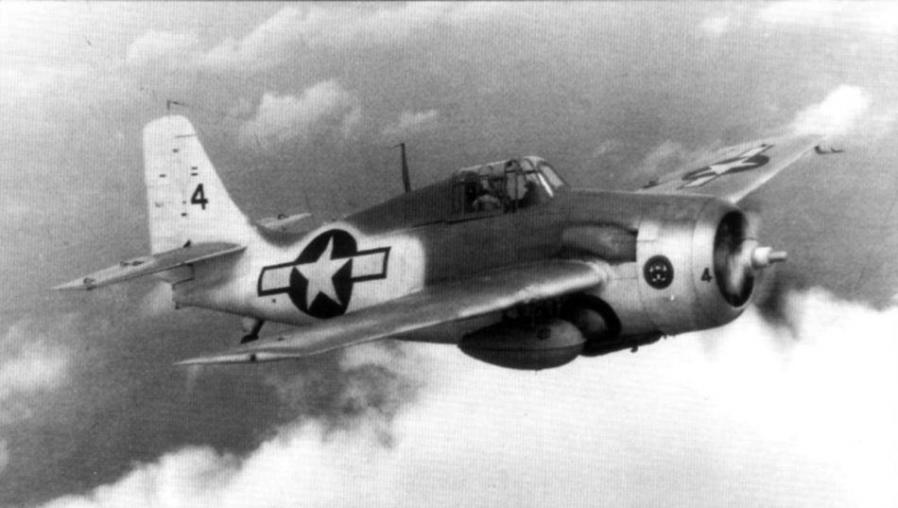
FM-2 - Composite Squadron (VC) 13, USS Tripoli (CVE 64), mars/March 1944 - © US Navy (domaine public - public domain)
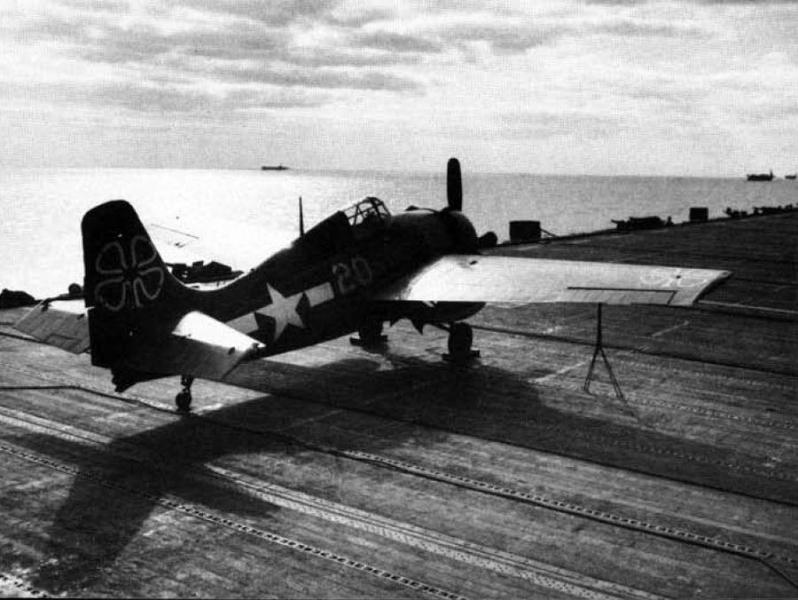
Eastern Aircraft FM-2, VC-93 - USS Petrof Bay (CVE-80) - 11 mai 1945 - 11th May, 1945.
© National Archives (domaine public - public domain)
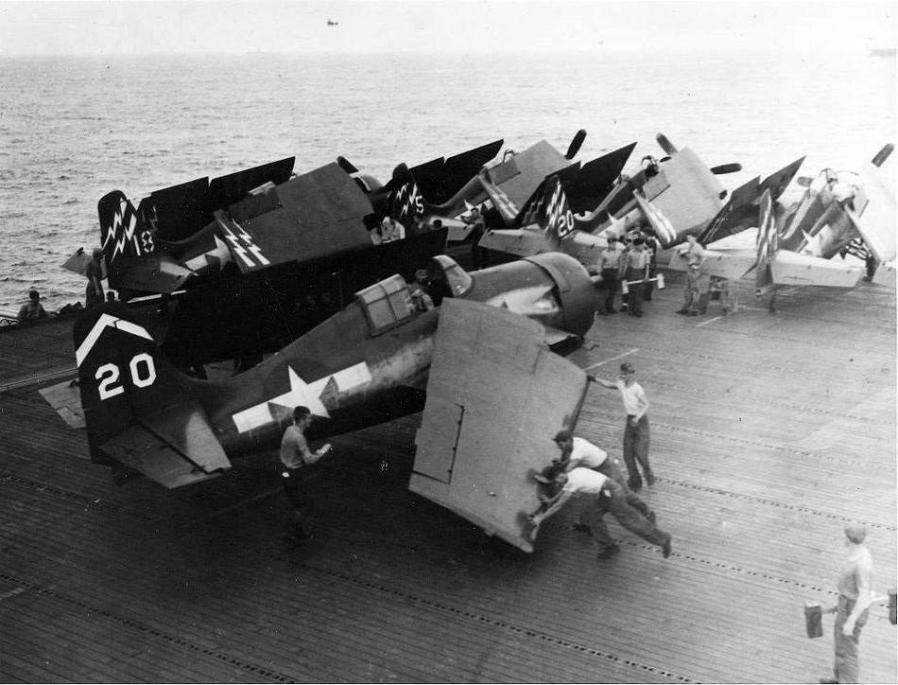
Eastern Aircraft FM-2, VC-85 - USS Hoggatt Bay (CVE-85) - 2 juillet 1945 - 2 July, 1945.
© National Archives (domaine public - public domain)
F4F-8 produit par Eastern Aircraft sous l'appelation FM-2, 4 777 exemplaires (5 523 selon une autre source).
F4F-8 manufactured by Eastern Aircraft under the name FM-2, 4,777 units (5,523 according to another source).
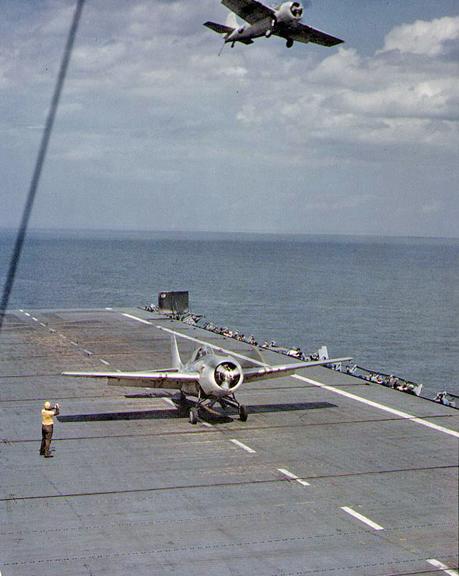 FM-2 - USS Charger, 1944 - © US Navy (domaine public - public domain)
FM-2 - USS Charger, 1944 - © US Navy (domaine public - public domain)
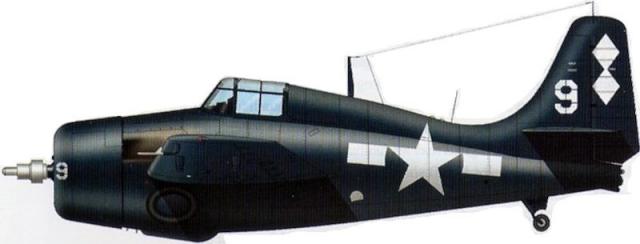
General Motors FM-2 - USS Sargent Bay (VC-79) - Mars 1945 - March, 1945
© P.A. Tilley
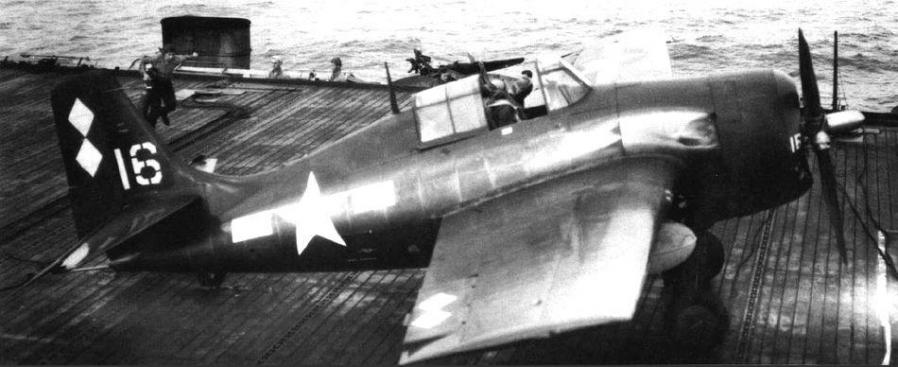
FM-2, VC-83 - USS Sargent Bay (CVE-83), Lt. JG McElroy,
La roulette de queue s'est cassée à l'atterissage, 1 mai 1945 - The tail wheel has broken when landing, 1st May 1945
© US National archives (domaine public - public domain)
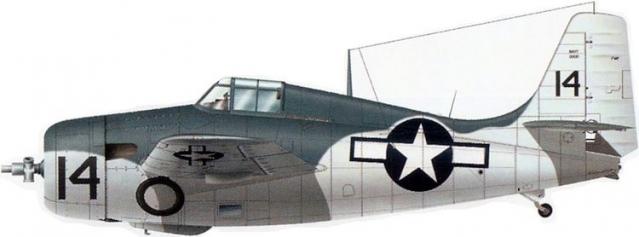
General Motors FM-2 - VC-9 - USS Solomons (CVE-67)
Océan Atlantique, juin 1944 - Atlantic Ocean, June 1944
© Jean-Marie Guillou
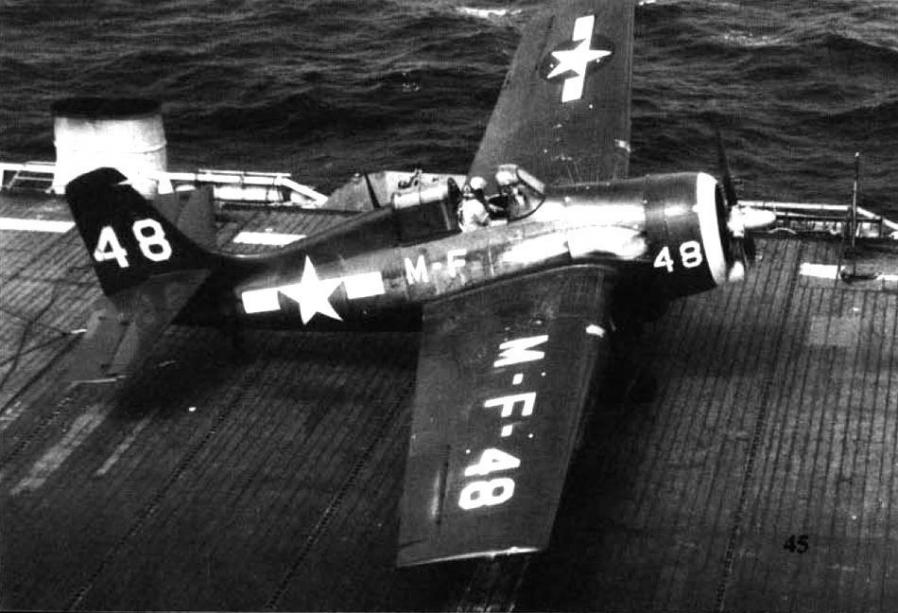
Eastern Aircraft FM-2 - USS Solomons (CVE-67)
3 mai 1945 - 3 May 1945 © US National archives (domaine public - public domain)
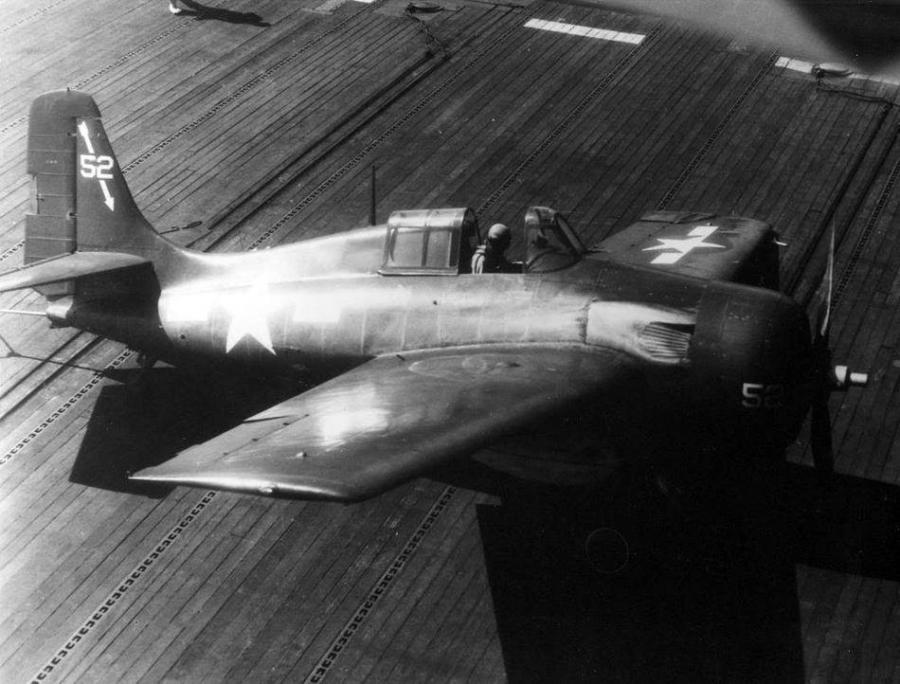
FM-2, VC-27 - USS Savo Island (CVE-78),1945 © US Navy (domaine public - public domain)
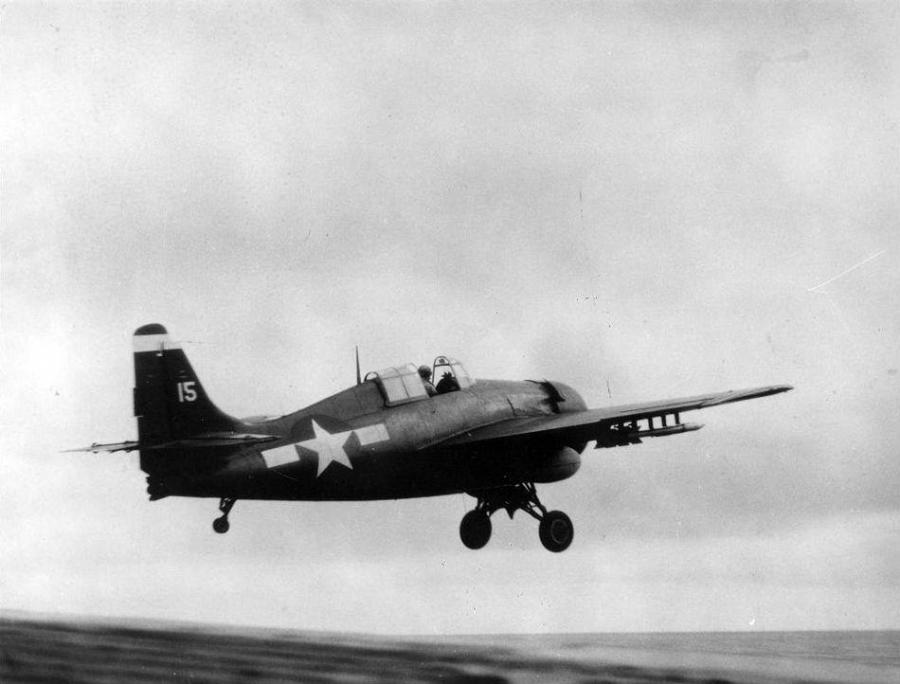
FM-2, VC-8 - USS Makin Island (CVE-93), 29 mars/March 1945 © US National Archives (domaine public - public domain)
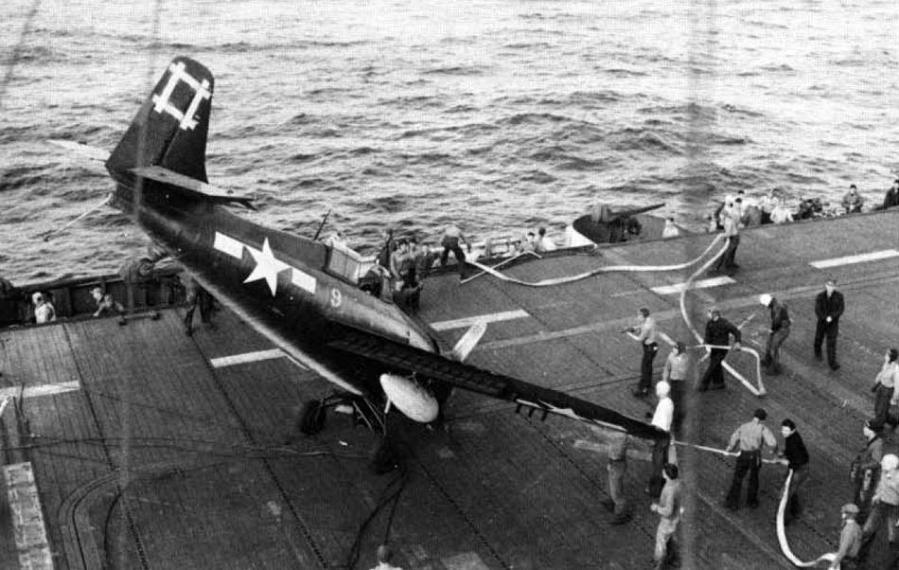
FM-2, VC-96 - USS Rudyerd Bay (CVE-81)
Sur le nez après avoir touché la barrière d'arrêt, 1er avril 1945 - On the nose after engaging the crash barrier, 1st April, 1945
© US Navy (domaine public - public domain)
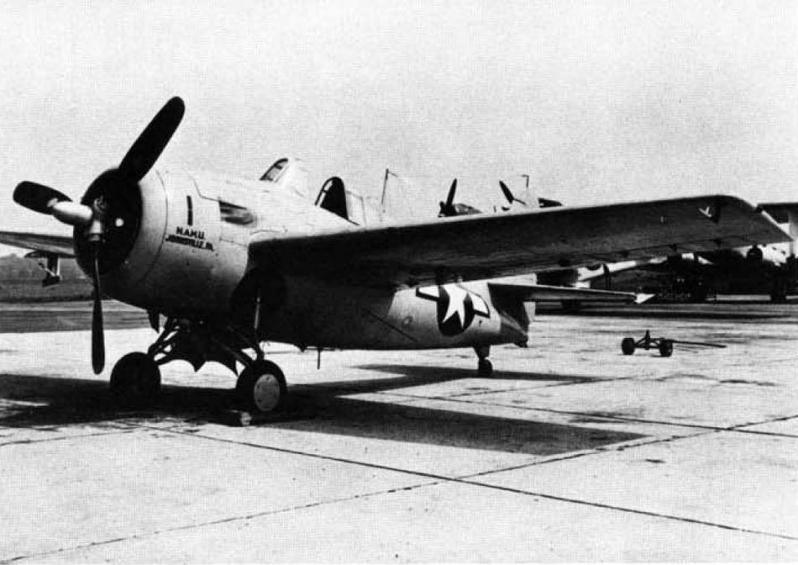
General Motors FM-2- Avion d'entraînement de couleur jaune-orange. Orange-yellow color training aircraft.
© National Air and Space Museum
Martlet VI
370 (ou 340) FM-2 en service dans la Royal Navy.
370 (or 340) FM-2 used in the Roral Navy.
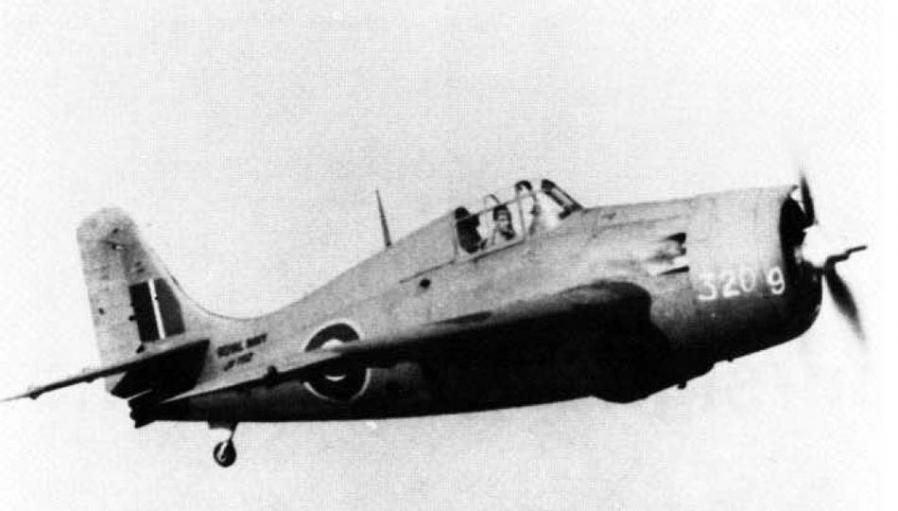
Martlet VI (JV752) - Vol test avant livraison à la Fleet Air Arm - Test flight prior to delivery to the Fleet Air Arm
Photo : source et auteur inconnus - Source and author unkown
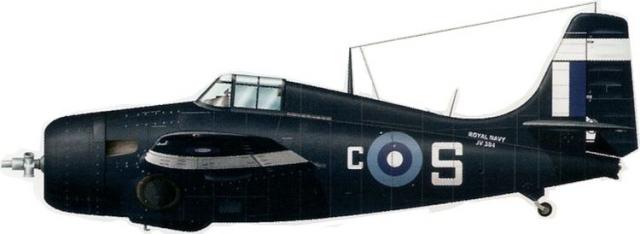
General Motors Mk VI - No 882 Squadron, HMS Searcher
Océan Pacifique, août 1945 - Pacific Ocean, August 1945
© Jean-Marie Guillou
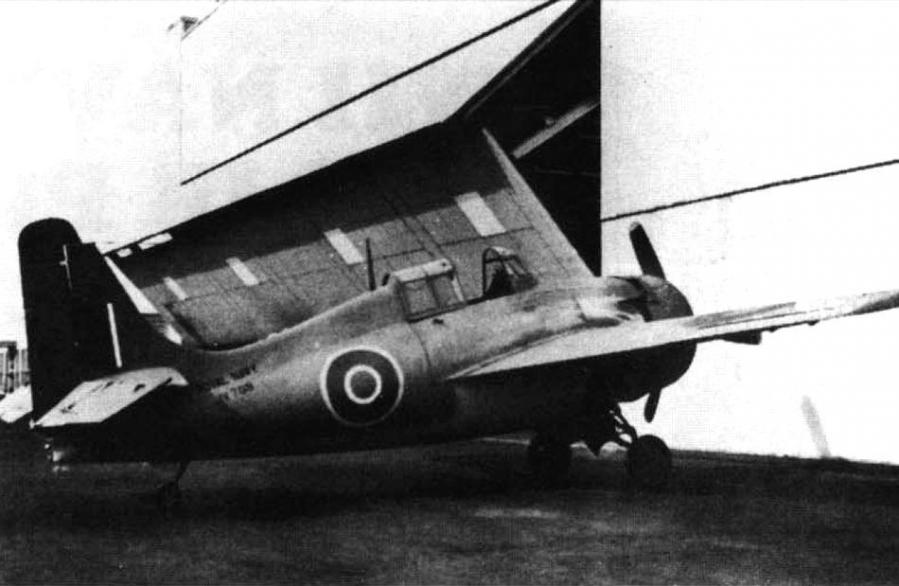
Martlet VI (JV708) - Eastern Aircraft, Linden, New Jersey
Photo : source et auteur inconnus - Source and author unkown
Production totale - Total production
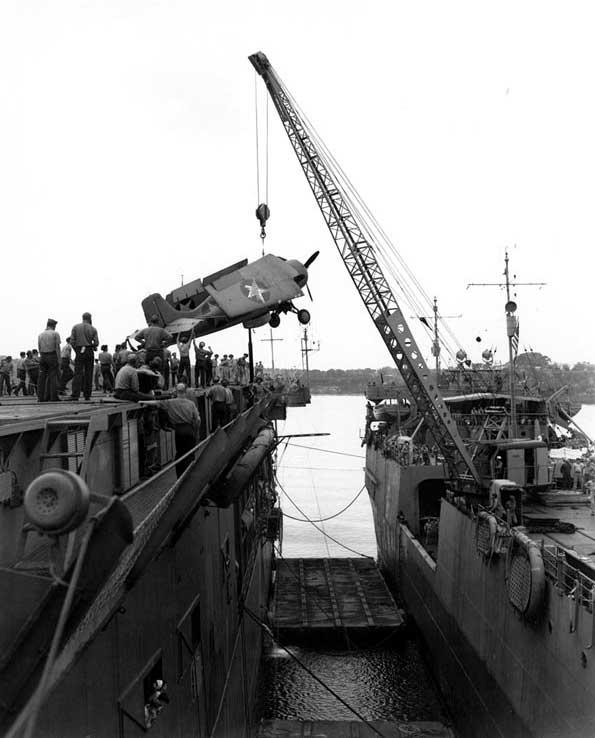
USS Long Island
Un Wildcat est chargé depuis l'APV Kitty Hawk, Fila Harbor, Nouvelles Hébrides, 28 août 1942
A Wildcat lifted from APV Kitty, Fila Harbor, New Hebrides, 28 Aug 1942
© US Navy (domaine public - public domain)

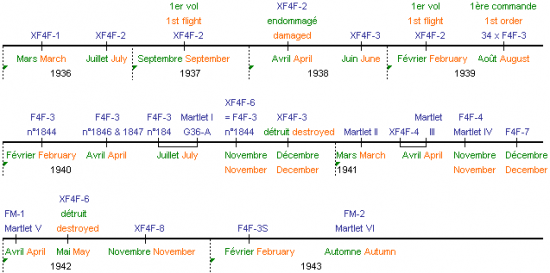

Fiche technique - Technical data
F4F-4
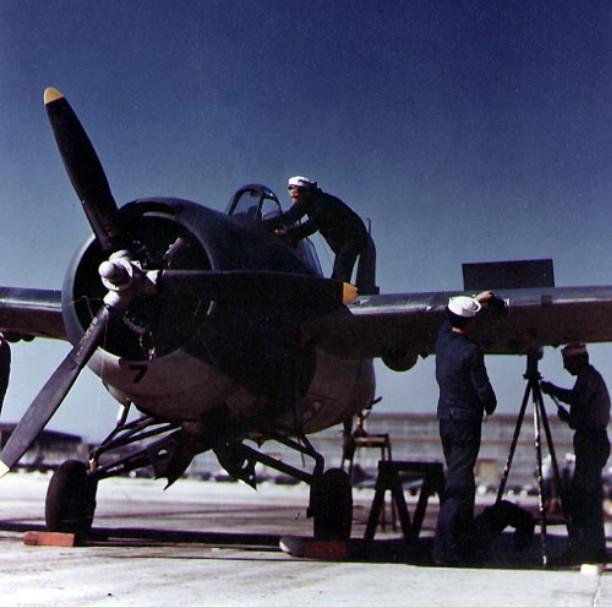
Wildcat 1942/1943 - © Naval Historical Center - (US Navy) - www.history.navy.mil
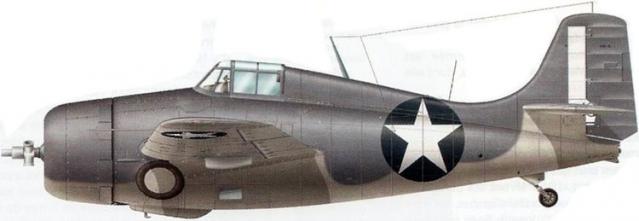
Grumman F4F-4 (F4F-3P ?), VMO-155 (détachment), USS Nassau (CVE-15)
Iles Aléoutiennes, Attu, mai 1943 - Aleutians islands, Attu, May 1943
© Jean-Marie Guillou
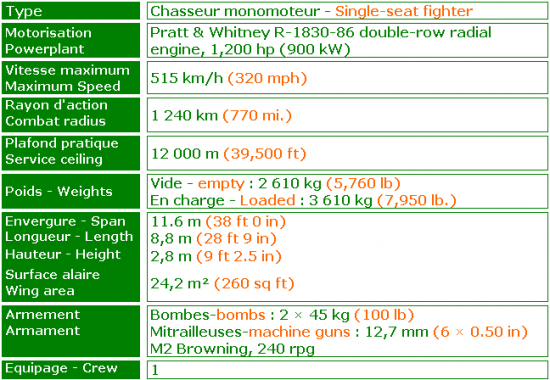
As sur Wildcat - Wildact aces
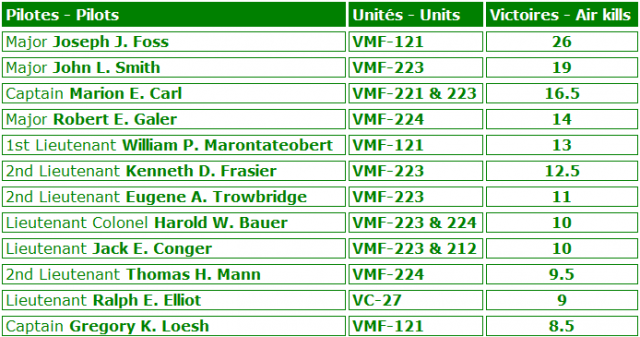
Théatres d'opération - Operational history
Dans l'océan Pacifique - In the pacific ocean
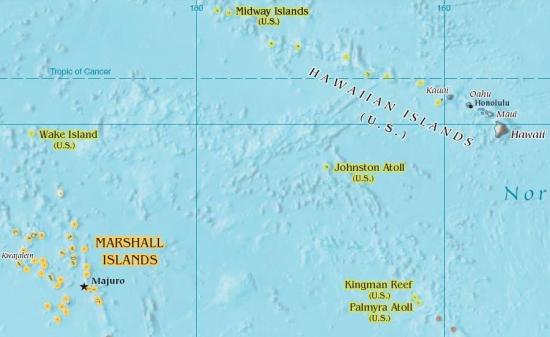
(© CIA World Factbook - domaine public - public domain)
De Guantanamo à Pearl Harbor
From Guantanamo to Pearl Harbor
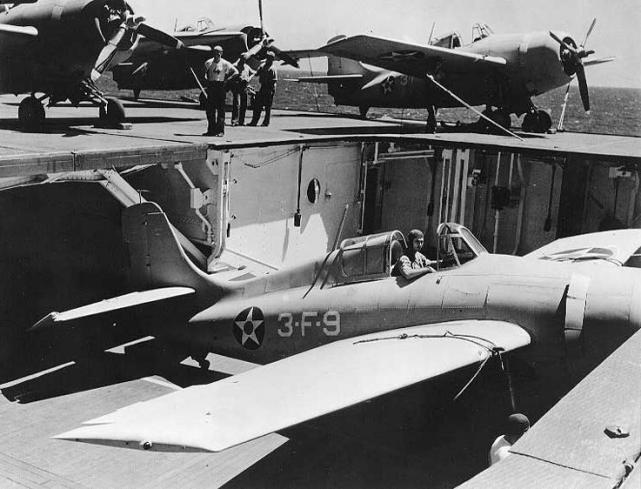
Grumman F4F-3 (BuAer 3982), Ensign Gayle Hermann - USS Saratoga, Octobre/October 1941
© United States Navy Naval History and Heritage Command
En décembre 1940, les VF-4 (CV-4 USS Ranger) et VF-7 (CV-7 USS Wasp), de l'US Navy, disposent de 22 modèles F4F-3. Fin janvier 1941, ces 2 unités manoeuvrent vers Guantanamo (Cuba) avec des avions aux couleurs flamboyantes :
- extrados d'ailes jaune vif et fuselage et intrados gris
- empennage vert (USS Ranger) ou noir (USS Wasp)
- 3 escadrilles de 6 appareils : bande de couleur de capot moteur et de fuselage pour la 1ère escadrille, placard sur la moitié supérieure du capot pour la 2ème escadrille et sur la moitié inférieure pour la 3ème.
- 6 sections de 3 avions avec des chevrons de couleur sur et sous les ailes : rouge pour les appareils numérotés de 1 à 3, blanc de 4 à 6, bleu de 7 à 9, noir de 10 à 12, vert de 13 à 15 et jaune de 16 à 18.
In December 1940, the VF-4 (CV-4 USS Ranger) and VF-7 (CV-7 USS Wasp), of the US Navy, have 22 F4F-3 models. At the end of January 1941, these 2 units operate in the area of Guantanamo (Cuba) with aircrafts decorated with the blazing colors:
- upper-wings sharp yellow and fuselage and under-wings gray
- empennage green (USS Ranger) or black (USS Wasp)
- 3 squadrons of 6 aircrafts : colored strip on engine hood and fuselage for the 1st squadron, colored surface on the upper half part of the engine hood for the 2nd squadron and on the lower half part for the 3rd.
- 6 sections of 3 aircrafts with colored strips above and under the wings : red for planes numbered from 1 to 3, white from 4 to 6, blue from 7 to 9, black from 10 to 12, green from 13 to 15 and yellow from 16 to 18.
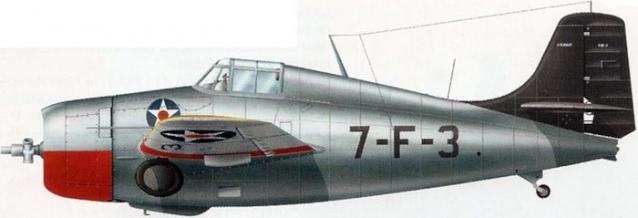
F4F-3 - VF-7 - USS Wasp (CV-7), 1940
Avion n° 3, 1ère section de la 3ème escadrille. Aircraft #3, 1st section - 3rd squadron.
© Jean-Marie Guillou
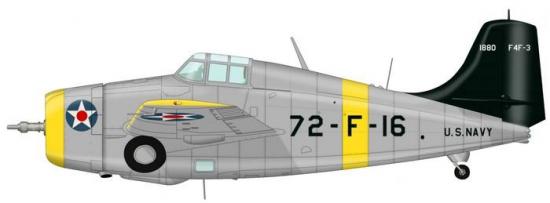
F4F-3 - VF-72 - USS Wasp, 1941
Avion n° 16, 6ème section de la 1ère escadrille. Aircraft #16, 6th section - 1st squadron.
© Gaëtan Marie - source : Gaëtan Marie's Aviation Profiles http://www.gaetanmarie.com

F4F-3 - VF-72 - Guantanamo Bay, USS Wasp, 25/02/1941
© US National Archives

F4F-3 - VF-41- USS Ranger, 1941
Avion n° 7, 3ème section de la 1ère escadrille. Aircraft #7, 3th section - 1st squadron.
© Gaëtan Marie - source : Gaëtan Marie's Aviation Profiles http://www.gaetanmarie.com
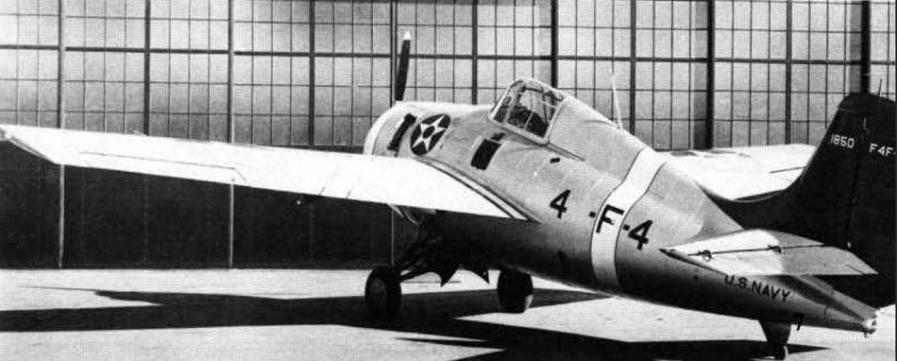
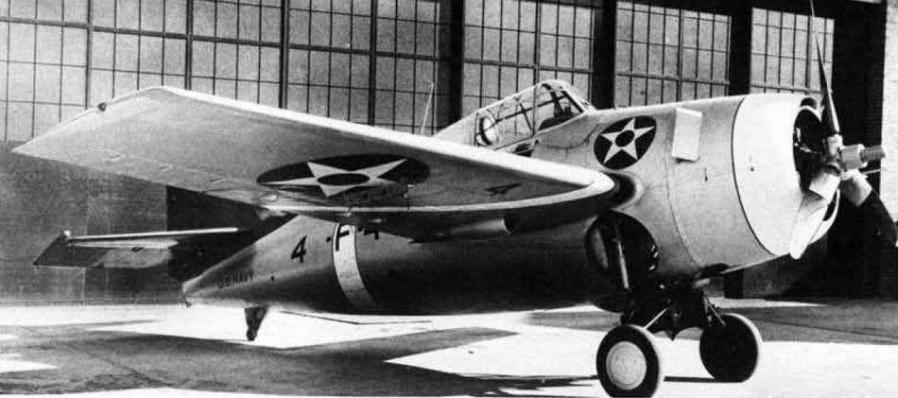
Grumman F4F-3, Bu No 1850, VF-41, USS Ranger
© US National Archives
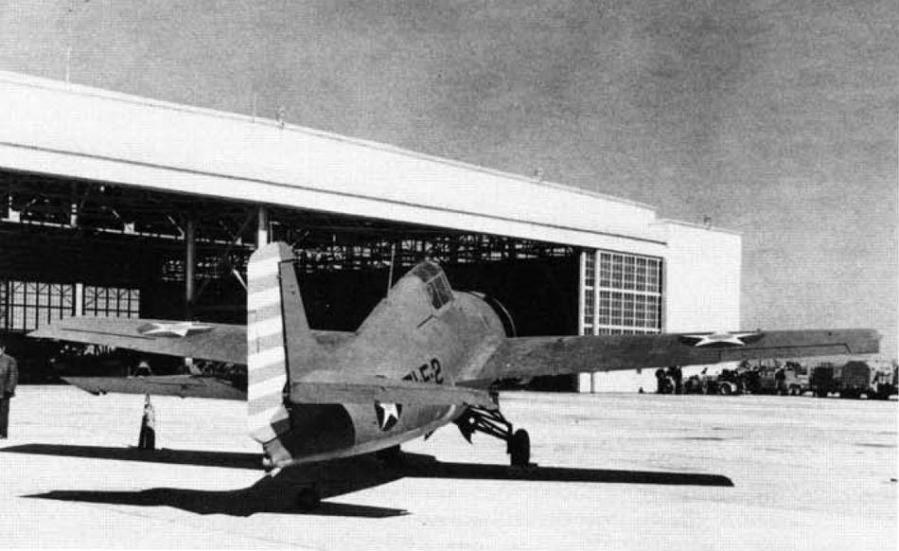
F4F-3 - NAS Norfolk, Virginie, 10 février 1942 - Virginia, 10th February 1942
Affecté au VF-71, USS Wasp (CV-7) - Assigned to VF-71, USS Wasp (CV-7)
© US Navy (domaine public - public doamin)

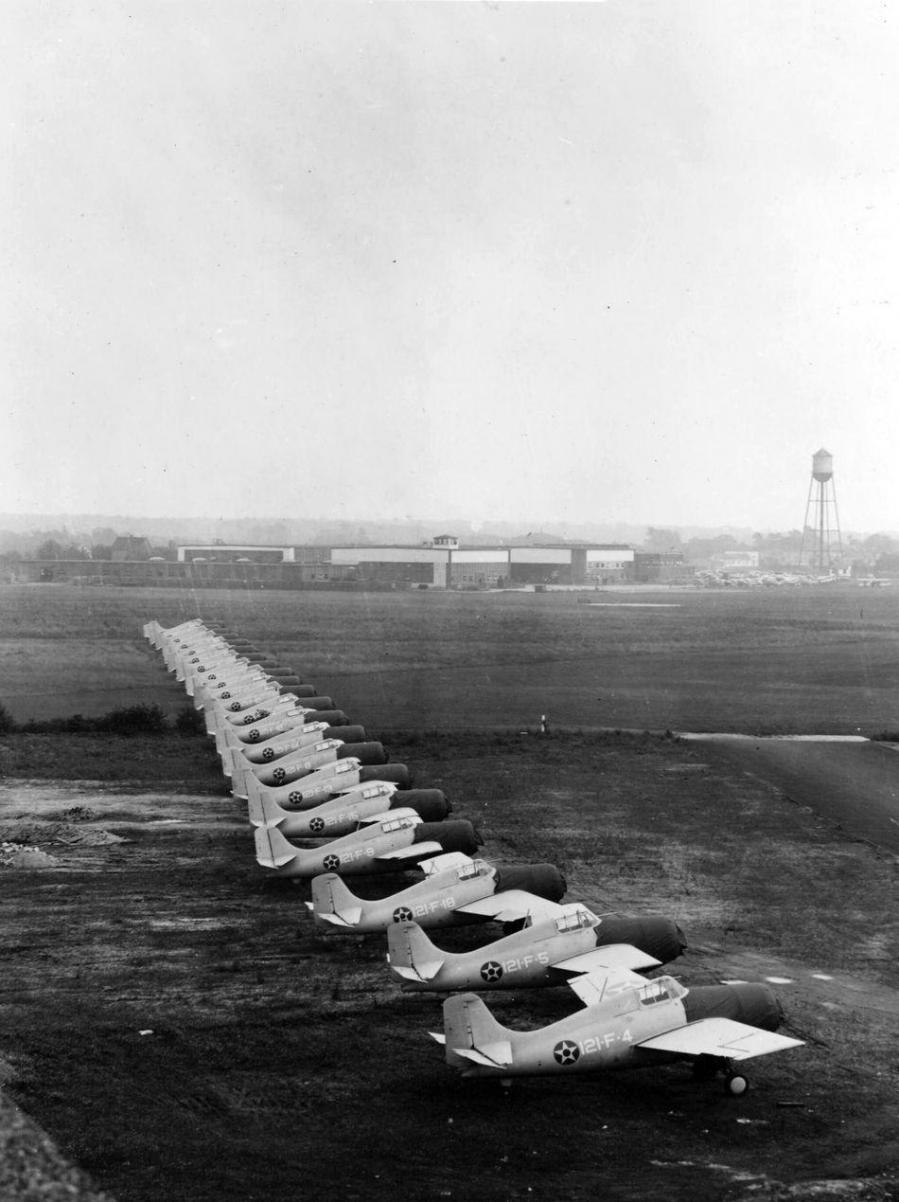
21 Grumman F4F-3 Wildcats de l'U.S. Marine Corps du Marine Fighting Squadron VMF-121 en 1941
21 U.S. Marine Corps Grumman F4F-3 Wildcats of Marine Fighting Squadron VMF-121 in 1941
© US Navy National Museum of Naval Aviation (domaine public - public domain)
En octobre 1941, les Squadrons VF-4, 6, 7 et 71 ainsi que VMF-111, 121 et 211 de l'US Navy mais aussi le Squadron BAD-1 du US Marine Corps sont opérationnels sur F4F-3 ou F4F-3A. Le VMF-211, équipés de quinze F4F-3, était basé à Ewa, près de Pearl Harbor.
In October 1941, the Squadrons VF-4, 6, 7 and 71 las well as VMF-111, 121 and 211 of the US Navy but also the Squadron BAD-1 of the US Marine Corps are operational on F4F-3 or F4F-3A. The VMF-211, equipped with fifteen F4F-3, was based at Ewa airfield, close to Pearl Harbor.
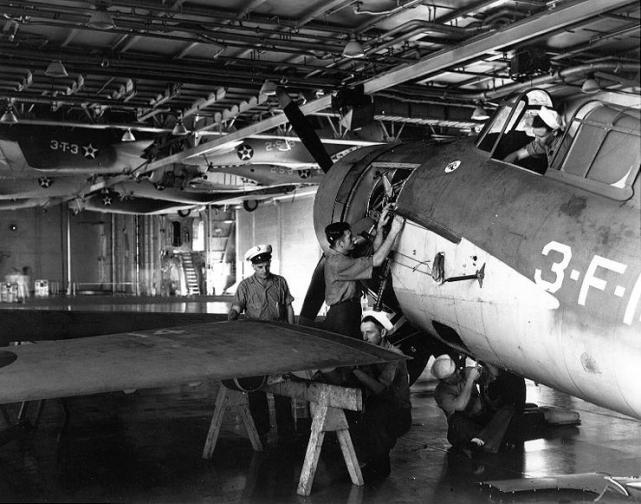
Grumman F4F-3, USS Enterprise, Octobre/October 1941
© US Navy (domaine public - public domain)
Lors de l'attaque du 7 décembre 1941, les Wildcat basés à Ewa n'eurent pas le temps d'intervenir et neuf d'entre eux furent détruits au sol. Heureusement, les porte-avions américains n'étaient pas à Pearl Harbor et ne furent pas détruits.
During the attack of December 7th, 1941, the Wildcats based in Ewa did not have time to itake off and nine of them were destroyed on the ground. By chance, the US aircraft-carriers were not at Pearl Harbor and escaped from destruction.
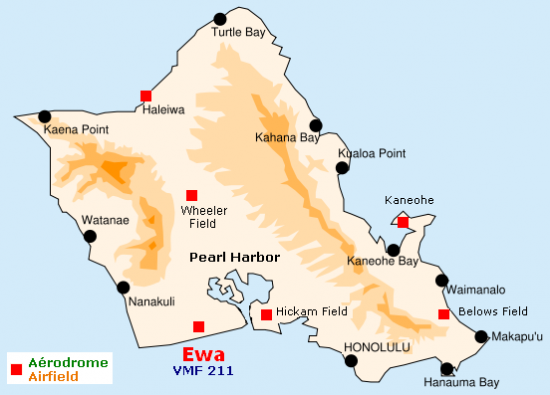
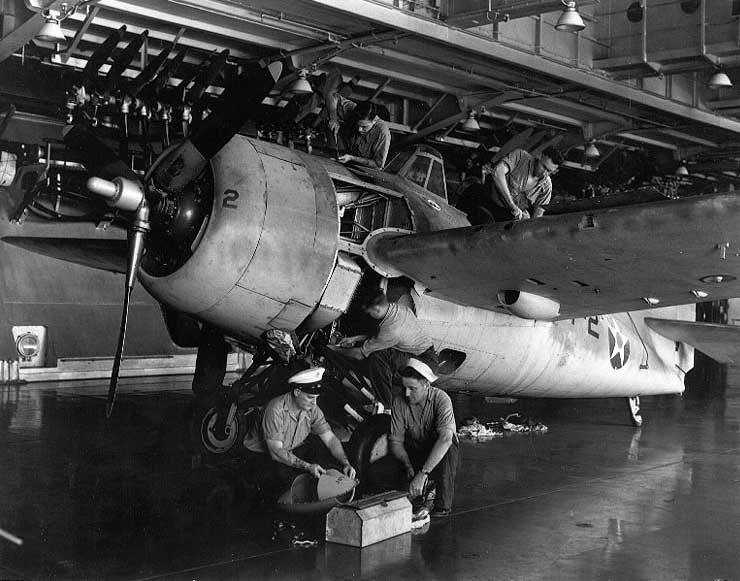
Grumman F4F-3, USS Enterprise (CV-6)
Equipe de maintenance de la VF-3 - VF-3 maintenance crews
© US Navy (domaine public - public domain)

